
11 Surprising Homework Statistics, Facts & Data

The age-old question of whether homework is good or bad for students is unanswerable because there are so many “ it depends ” factors.
For example, it depends on the age of the child, the type of homework being assigned, and even the child’s needs.
There are also many conflicting reports on whether homework is good or bad. This is a topic that largely relies on data interpretation for the researcher to come to their conclusions.
To cut through some of the fog, below I’ve outlined some great homework statistics that can help us understand the effects of homework on children.
Homework Statistics List
1. 45% of parents think homework is too easy for their children.
A study by the Center for American Progress found that parents are almost twice as likely to believe their children’s homework is too easy than to disagree with that statement.
Here are the figures for math homework:
- 46% of parents think their child’s math homework is too easy.
- 25% of parents think their child’s math homework is not too easy.
- 29% of parents offered no opinion.
Here are the figures for language arts homework:
- 44% of parents think their child’s language arts homework is too easy.
- 28% of parents think their child’s language arts homework is not too easy.
- 28% of parents offered no opinion.
These findings are based on online surveys of 372 parents of school-aged children conducted in 2018.
2. 93% of Fourth Grade Children Worldwide are Assigned Homework
The prestigious worldwide math assessment Trends in International Maths and Science Study (TIMSS) took a survey of worldwide homework trends in 2007. Their study concluded that 93% of fourth-grade children are regularly assigned homework, while just 7% never or rarely have homework assigned.
3. 17% of Teens Regularly Miss Homework due to Lack of High-Speed Internet Access
A 2018 Pew Research poll of 743 US teens found that 17%, or almost 2 in every 5 students, regularly struggled to complete homework because they didn’t have reliable access to the internet.
This figure rose to 25% of Black American teens and 24% of teens whose families have an income of less than $30,000 per year.
4. Parents Spend 6.7 Hours Per Week on their Children’s Homework
A 2018 study of 27,500 parents around the world found that the average amount of time parents spend on homework with their child is 6.7 hours per week. Furthermore, 25% of parents spend more than 7 hours per week on their child’s homework.
American parents spend slightly below average at 6.2 hours per week, while Indian parents spend 12 hours per week and Japanese parents spend 2.6 hours per week.
5. Students in High-Performing High Schools Spend on Average 3.1 Hours per night Doing Homework
A study by Galloway, Conner & Pope (2013) conducted a sample of 4,317 students from 10 high-performing high schools in upper-middle-class California.
Across these high-performing schools, students self-reported that they did 3.1 hours per night of homework.
Graduates from those schools also ended up going on to college 93% of the time.
6. One to Two Hours is the Optimal Duration for Homework
A 2012 peer-reviewed study in the High School Journal found that students who conducted between one and two hours achieved higher results in tests than any other group.
However, the authors were quick to highlight that this “t is an oversimplification of a much more complex problem.” I’m inclined to agree. The greater variable is likely the quality of the homework than time spent on it.
Nevertheless, one result was unequivocal: that some homework is better than none at all : “students who complete any amount of homework earn higher test scores than their peers who do not complete homework.”
7. 74% of Teens cite Homework as a Source of Stress
A study by the Better Sleep Council found that homework is a source of stress for 74% of students. Only school grades, at 75%, rated higher in the study.
That figure rises for girls, with 80% of girls citing homework as a source of stress.
Similarly, the study by Galloway, Conner & Pope (2013) found that 56% of students cite homework as a “primary stressor” in their lives.
8. US Teens Spend more than 15 Hours per Week on Homework
The same study by the Better Sleep Council also found that US teens spend over 2 hours per school night on homework, and overall this added up to over 15 hours per week.
Surprisingly, 4% of US teens say they do more than 6 hours of homework per night. That’s almost as much homework as there are hours in the school day.
The only activity that teens self-reported as doing more than homework was engaging in electronics, which included using phones, playing video games, and watching TV.
9. The 10-Minute Rule
The National Education Association (USA) endorses the concept of doing 10 minutes of homework per night per grade.
For example, if you are in 3rd grade, you should do 30 minutes of homework per night. If you are in 4th grade, you should do 40 minutes of homework per night.
However, this ‘rule’ appears not to be based in sound research. Nevertheless, it is true that homework benefits (no matter the quality of the homework) will likely wane after 2 hours (120 minutes) per night, which would be the NEA guidelines’ peak in grade 12.
10. 21.9% of Parents are Too Busy for their Children’s Homework
An online poll of nearly 300 parents found that 21.9% are too busy to review their children’s homework. On top of this, 31.6% of parents do not look at their children’s homework because their children do not want their help. For these parents, their children’s unwillingness to accept their support is a key source of frustration.
11. 46.5% of Parents find Homework too Hard
The same online poll of parents of children from grades 1 to 12 also found that many parents struggle to help their children with homework because parents find it confusing themselves. Unfortunately, the study did not ask the age of the students so more data is required here to get a full picture of the issue.
Get a Pdf of this article for class
Enjoy subscriber-only access to this article’s pdf
Interpreting the Data
Unfortunately, homework is one of those topics that can be interpreted by different people pursuing differing agendas. All studies of homework have a wide range of variables, such as:
- What age were the children in the study?
- What was the homework they were assigned?
- What tools were available to them?
- What were the cultural attitudes to homework and how did they impact the study?
- Is the study replicable?
The more questions we ask about the data, the more we realize that it’s hard to come to firm conclusions about the pros and cons of homework .
Furthermore, questions about the opportunity cost of homework remain. Even if homework is good for children’s test scores, is it worthwhile if the children consequently do less exercise or experience more stress?
Thus, this ends up becoming a largely qualitative exercise. If parents and teachers zoom in on an individual child’s needs, they’ll be able to more effectively understand how much homework a child needs as well as the type of homework they should be assigned.
Related: Funny Homework Excuses
The debate over whether homework should be banned will not be resolved with these homework statistics. But, these facts and figures can help you to pursue a position in a school debate on the topic – and with that, I hope your debate goes well and you develop some great debating skills!

Chris Drew (PhD)
Dr. Chris Drew is the founder of the Helpful Professor. He holds a PhD in education and has published over 20 articles in scholarly journals. He is the former editor of the Journal of Learning Development in Higher Education. [Image Descriptor: Photo of Chris]
- Chris Drew (PhD) https://helpfulprofessor.com/author/chris-drew-phd/ Forest Schools Philosophy & Curriculum, Explained!
- Chris Drew (PhD) https://helpfulprofessor.com/author/chris-drew-phd/ Montessori's 4 Planes of Development, Explained!
- Chris Drew (PhD) https://helpfulprofessor.com/author/chris-drew-phd/ Montessori vs Reggio Emilia vs Steiner-Waldorf vs Froebel
- Chris Drew (PhD) https://helpfulprofessor.com/author/chris-drew-phd/ Parten’s 6 Stages of Play in Childhood, Explained!
Leave a Comment Cancel Reply
Your email address will not be published. Required fields are marked *
- Future Students
- Current Students
- Faculty/Staff

News and Media
- News & Media Home
- Research Stories
- School's In
- In the Media
You are here
More than two hours of homework may be counterproductive, research suggests.

A Stanford education researcher found that too much homework can negatively affect kids, especially their lives away from school, where family, friends and activities matter. "Our findings on the effects of homework challenge the traditional assumption that homework is inherently good," wrote Denise Pope , a senior lecturer at the Stanford Graduate School of Education and a co-author of a study published in the Journal of Experimental Education . The researchers used survey data to examine perceptions about homework, student well-being and behavioral engagement in a sample of 4,317 students from 10 high-performing high schools in upper-middle-class California communities. Along with the survey data, Pope and her colleagues used open-ended answers to explore the students' views on homework. Median household income exceeded $90,000 in these communities, and 93 percent of the students went on to college, either two-year or four-year. Students in these schools average about 3.1 hours of homework each night. "The findings address how current homework practices in privileged, high-performing schools sustain students' advantage in competitive climates yet hinder learning, full engagement and well-being," Pope wrote. Pope and her colleagues found that too much homework can diminish its effectiveness and even be counterproductive. They cite prior research indicating that homework benefits plateau at about two hours per night, and that 90 minutes to two and a half hours is optimal for high school. Their study found that too much homework is associated with: • Greater stress : 56 percent of the students considered homework a primary source of stress, according to the survey data. Forty-three percent viewed tests as a primary stressor, while 33 percent put the pressure to get good grades in that category. Less than 1 percent of the students said homework was not a stressor. • Reductions in health : In their open-ended answers, many students said their homework load led to sleep deprivation and other health problems. The researchers asked students whether they experienced health issues such as headaches, exhaustion, sleep deprivation, weight loss and stomach problems. • Less time for friends, family and extracurricular pursuits : Both the survey data and student responses indicate that spending too much time on homework meant that students were "not meeting their developmental needs or cultivating other critical life skills," according to the researchers. Students were more likely to drop activities, not see friends or family, and not pursue hobbies they enjoy. A balancing act The results offer empirical evidence that many students struggle to find balance between homework, extracurricular activities and social time, the researchers said. Many students felt forced or obligated to choose homework over developing other talents or skills. Also, there was no relationship between the time spent on homework and how much the student enjoyed it. The research quoted students as saying they often do homework they see as "pointless" or "mindless" in order to keep their grades up. "This kind of busy work, by its very nature, discourages learning and instead promotes doing homework simply to get points," said Pope, who is also a co-founder of Challenge Success , a nonprofit organization affiliated with the GSE that conducts research and works with schools and parents to improve students' educational experiences.. Pope said the research calls into question the value of assigning large amounts of homework in high-performing schools. Homework should not be simply assigned as a routine practice, she said. "Rather, any homework assigned should have a purpose and benefit, and it should be designed to cultivate learning and development," wrote Pope. High-performing paradox In places where students attend high-performing schools, too much homework can reduce their time to foster skills in the area of personal responsibility, the researchers concluded. "Young people are spending more time alone," they wrote, "which means less time for family and fewer opportunities to engage in their communities." Student perspectives The researchers say that while their open-ended or "self-reporting" methodology to gauge student concerns about homework may have limitations – some might regard it as an opportunity for "typical adolescent complaining" – it was important to learn firsthand what the students believe. The paper was co-authored by Mollie Galloway from Lewis and Clark College and Jerusha Conner from Villanova University.
Clifton B. Parker is a writer at the Stanford News Service .
More Stories

⟵ Go to all Research Stories
Get the Educator
Subscribe to our monthly newsletter.
Stanford Graduate School of Education
482 Galvez Mall Stanford, CA 94305-3096 Tel: (650) 723-2109
- Contact Admissions
- GSE Leadership
- Site Feedback
- Web Accessibility
- Career Resources
- Faculty Open Positions
- Explore Courses
- Academic Calendar
- Office of the Registrar
- Cubberley Library
- StanfordWho
- StanfordYou
Improving lives through learning

- Stanford Home
- Maps & Directions
- Search Stanford
- Emergency Info
- Terms of Use
- Non-Discrimination
- Accessibility
© Stanford University , Stanford , California 94305 .
Is it time to get rid of homework? Mental health experts weigh in.

It's no secret that kids hate homework. And as students grapple with an ongoing pandemic that has had a wide range of mental health impacts, is it time schools start listening to their pleas about workloads?
Some teachers are turning to social media to take a stand against homework.
Tiktok user @misguided.teacher says he doesn't assign it because the "whole premise of homework is flawed."
For starters, he says, he can't grade work on "even playing fields" when students' home environments can be vastly different.
"Even students who go home to a peaceful house, do they really want to spend their time on busy work? Because typically that's what a lot of homework is, it's busy work," he says in the video that has garnered 1.6 million likes. "You only get one year to be 7, you only got one year to be 10, you only get one year to be 16, 18."
Mental health experts agree heavy workloads have the potential do more harm than good for students, especially when taking into account the impacts of the pandemic. But they also say the answer may not be to eliminate homework altogether.
Emmy Kang, mental health counselor at Humantold , says studies have shown heavy workloads can be "detrimental" for students and cause a "big impact on their mental, physical and emotional health."
"More than half of students say that homework is their primary source of stress, and we know what stress can do on our bodies," she says, adding that staying up late to finish assignments also leads to disrupted sleep and exhaustion.
Cynthia Catchings, a licensed clinical social worker and therapist at Talkspace , says heavy workloads can also cause serious mental health problems in the long run, like anxiety and depression.
And for all the distress homework can cause, it's not as useful as many may think, says Dr. Nicholas Kardaras, a psychologist and CEO of Omega Recovery treatment center.
"The research shows that there's really limited benefit of homework for elementary age students, that really the school work should be contained in the classroom," he says.
For older students, Kang says, homework benefits plateau at about two hours per night.
"Most students, especially at these high achieving schools, they're doing a minimum of three hours, and it's taking away time from their friends, from their families, their extracurricular activities. And these are all very important things for a person's mental and emotional health."
Catchings, who also taught third to 12th graders for 12 years, says she's seen the positive effects of a no-homework policy while working with students abroad.
"Not having homework was something that I always admired from the French students (and) the French schools, because that was helping the students to really have the time off and really disconnect from school," she says.
The answer may not be to eliminate homework completely but to be more mindful of the type of work students take home, suggests Kang, who was a high school teacher for 10 years.
"I don't think (we) should scrap homework; I think we should scrap meaningless, purposeless busy work-type homework. That's something that needs to be scrapped entirely," she says, encouraging teachers to be thoughtful and consider the amount of time it would take for students to complete assignments.
The pandemic made the conversation around homework more crucial
Mindfulness surrounding homework is especially important in the context of the past two years. Many students will be struggling with mental health issues that were brought on or worsened by the pandemic , making heavy workloads even harder to balance.
"COVID was just a disaster in terms of the lack of structure. Everything just deteriorated," Kardaras says, pointing to an increase in cognitive issues and decrease in attention spans among students. "School acts as an anchor for a lot of children, as a stabilizing force, and that disappeared."
But even if students transition back to the structure of in-person classes, Kardaras suspects students may still struggle after two school years of shifted schedules and disrupted sleeping habits.
"We've seen adults struggling to go back to in-person work environments from remote work environments. That effect is amplified with children because children have less resources to be able to cope with those transitions than adults do," he explains.
'Get organized' ahead of back-to-school
In order to make the transition back to in-person school easier, Kang encourages students to "get good sleep, exercise regularly (and) eat a healthy diet."
To help manage workloads, she suggests students "get organized."
"There's so much mental clutter up there when you're disorganized. ... Sitting down and planning out their study schedules can really help manage their time," she says.
Breaking up assignments can also make things easier to tackle.
"I know that heavy workloads can be stressful, but if you sit down and you break down that studying into smaller chunks, they're much more manageable."
If workloads are still too much, Kang encourages students to advocate for themselves.
"They should tell their teachers when a homework assignment just took too much time or if it was too difficult for them to do on their own," she says. "It's good to speak up and ask those questions. Respectfully, of course, because these are your teachers. But still, I think sometimes teachers themselves need this feedback from their students."
More: Some teachers let their students sleep in class. Here's what mental health experts say.
More: Some parents are slipping young kids in for the COVID-19 vaccine, but doctors discourage the move as 'risky'
- About the Hub
- Announcements
- Faculty Experts Guide
- Subscribe to the newsletter
Explore by Topic
- Arts+Culture
- Politics+Society
- Science+Technology
- Student Life
- University News
- Voices+Opinion
- About Hub at Work
- Gazette Archive
- Benefits+Perks
- Health+Well-Being
- Current Issue
- About the Magazine
- Past Issues
- Support Johns Hopkins Magazine
- Subscribe to the Magazine
You are using an outdated browser. Please upgrade your browser to improve your experience.

Credit: August de Richelieu
Does homework still have value? A Johns Hopkins education expert weighs in
Joyce epstein, co-director of the center on school, family, and community partnerships, discusses why homework is essential, how to maximize its benefit to learners, and what the 'no-homework' approach gets wrong.
By Vicky Hallett
The necessity of homework has been a subject of debate since at least as far back as the 1890s, according to Joyce L. Epstein , co-director of the Center on School, Family, and Community Partnerships at Johns Hopkins University. "It's always been the case that parents, kids—and sometimes teachers, too—wonder if this is just busy work," Epstein says.
But after decades of researching how to improve schools, the professor in the Johns Hopkins School of Education remains certain that homework is essential—as long as the teachers have done their homework, too. The National Network of Partnership Schools , which she founded in 1995 to advise schools and districts on ways to improve comprehensive programs of family engagement, has developed hundreds of improved homework ideas through its Teachers Involve Parents in Schoolwork program. For an English class, a student might interview a parent on popular hairstyles from their youth and write about the differences between then and now. Or for science class, a family could identify forms of matter over the dinner table, labeling foods as liquids or solids. These innovative and interactive assignments not only reinforce concepts from the classroom but also foster creativity, spark discussions, and boost student motivation.
"We're not trying to eliminate homework procedures, but expand and enrich them," says Epstein, who is packing this research into a forthcoming book on the purposes and designs of homework. In the meantime, the Hub couldn't wait to ask her some questions:
What kind of homework training do teachers typically get?
Future teachers and administrators really have little formal training on how to design homework before they assign it. This means that most just repeat what their teachers did, or they follow textbook suggestions at the end of units. For example, future teachers are well prepared to teach reading and literacy skills at each grade level, and they continue to learn to improve their teaching of reading in ongoing in-service education. By contrast, most receive little or no training on the purposes and designs of homework in reading or other subjects. It is really important for future teachers to receive systematic training to understand that they have the power, opportunity, and obligation to design homework with a purpose.
Why do students need more interactive homework?
If homework assignments are always the same—10 math problems, six sentences with spelling words—homework can get boring and some kids just stop doing their assignments, especially in the middle and high school years. When we've asked teachers what's the best homework you've ever had or designed, invariably we hear examples of talking with a parent or grandparent or peer to share ideas. To be clear, parents should never be asked to "teach" seventh grade science or any other subject. Rather, teachers set up the homework assignments so that the student is in charge. It's always the student's homework. But a good activity can engage parents in a fun, collaborative way. Our data show that with "good" assignments, more kids finish their work, more kids interact with a family partner, and more parents say, "I learned what's happening in the curriculum." It all works around what the youngsters are learning.
Is family engagement really that important?
At Hopkins, I am part of the Center for Social Organization of Schools , a research center that studies how to improve many aspects of education to help all students do their best in school. One thing my colleagues and I realized was that we needed to look deeply into family and community engagement. There were so few references to this topic when we started that we had to build the field of study. When children go to school, their families "attend" with them whether a teacher can "see" the parents or not. So, family engagement is ever-present in the life of a school.
My daughter's elementary school doesn't assign homework until third grade. What's your take on "no homework" policies?
There are some parents, writers, and commentators who have argued against homework, especially for very young children. They suggest that children should have time to play after school. This, of course is true, but many kindergarten kids are excited to have homework like their older siblings. If they give homework, most teachers of young children make assignments very short—often following an informal rule of 10 minutes per grade level. "No homework" does not guarantee that all students will spend their free time in productive and imaginative play.
Some researchers and critics have consistently misinterpreted research findings. They have argued that homework should be assigned only at the high school level where data point to a strong connection of doing assignments with higher student achievement . However, as we discussed, some students stop doing homework. This leads, statistically, to results showing that doing homework or spending more minutes on homework is linked to higher student achievement. If slow or struggling students are not doing their assignments, they contribute to—or cause—this "result."
Teachers need to design homework that even struggling students want to do because it is interesting. Just about all students at any age level react positively to good assignments and will tell you so.
Did COVID change how schools and parents view homework?
Within 24 hours of the day school doors closed in March 2020, just about every school and district in the country figured out that teachers had to talk to and work with students' parents. This was not the same as homeschooling—teachers were still working hard to provide daily lessons. But if a child was learning at home in the living room, parents were more aware of what they were doing in school. One of the silver linings of COVID was that teachers reported that they gained a better understanding of their students' families. We collected wonderfully creative examples of activities from members of the National Network of Partnership Schools. I'm thinking of one art activity where every child talked with a parent about something that made their family unique. Then they drew their finding on a snowflake and returned it to share in class. In math, students talked with a parent about something the family liked so much that they could represent it 100 times. Conversations about schoolwork at home was the point.
How did you create so many homework activities via the Teachers Involve Parents in Schoolwork program?
We had several projects with educators to help them design interactive assignments, not just "do the next three examples on page 38." Teachers worked in teams to create TIPS activities, and then we turned their work into a standard TIPS format in math, reading/language arts, and science for grades K-8. Any teacher can use or adapt our prototypes to match their curricula.
Overall, we know that if future teachers and practicing educators were prepared to design homework assignments to meet specific purposes—including but not limited to interactive activities—more students would benefit from the important experience of doing their homework. And more parents would, indeed, be partners in education.
Posted in Voices+Opinion
You might also like
News network.
- Johns Hopkins Magazine
- Get Email Updates
- Submit an Announcement
- Submit an Event
- Privacy Statement
- Accessibility
Discover JHU
- About the University
- Schools & Divisions
- Academic Programs
- Plan a Visit
- my.JohnsHopkins.edu
- © 2024 Johns Hopkins University . All rights reserved.
- University Communications
- 3910 Keswick Rd., Suite N2600, Baltimore, MD
- X Facebook LinkedIn YouTube Instagram
Does homework really work?
by: Leslie Crawford | Updated: December 12, 2023
Print article

You know the drill. It’s 10:15 p.m., and the cardboard-and-toothpick Golden Gate Bridge is collapsing. The pages of polynomials have been abandoned. The paper on the Battle of Waterloo seems to have frozen in time with Napoleon lingering eternally over his breakfast at Le Caillou. Then come the tears and tantrums — while we parents wonder, Does the gain merit all this pain? Is this just too much homework?
However the drama unfolds night after night, year after year, most parents hold on to the hope that homework (after soccer games, dinner, flute practice, and, oh yes, that childhood pastime of yore known as playing) advances their children academically.
But what does homework really do for kids? Is the forest’s worth of book reports and math and spelling sheets the average American student completes in their 12 years of primary schooling making a difference? Or is it just busywork?
Homework haterz
Whether or not homework helps, or even hurts, depends on who you ask. If you ask my 12-year-old son, Sam, he’ll say, “Homework doesn’t help anything. It makes kids stressed-out and tired and makes them hate school more.”
Nothing more than common kid bellyaching?
Maybe, but in the fractious field of homework studies, it’s worth noting that Sam’s sentiments nicely synopsize one side of the ivory tower debate. Books like The End of Homework , The Homework Myth , and The Case Against Homework the film Race to Nowhere , and the anguished parent essay “ My Daughter’s Homework is Killing Me ” make the case that homework, by taking away precious family time and putting kids under unneeded pressure, is an ineffective way to help children become better learners and thinkers.
One Canadian couple took their homework apostasy all the way to the Supreme Court of Canada. After arguing that there was no evidence that it improved academic performance, they won a ruling that exempted their two children from all homework.
So what’s the real relationship between homework and academic achievement?
How much is too much?
To answer this question, researchers have been doing their homework on homework, conducting and examining hundreds of studies. Chris Drew Ph.D., founder and editor at The Helpful Professor recently compiled multiple statistics revealing the folly of today’s after-school busy work. Does any of the data he listed below ring true for you?
• 45 percent of parents think homework is too easy for their child, primarily because it is geared to the lowest standard under the Common Core State Standards .
• 74 percent of students say homework is a source of stress , defined as headaches, exhaustion, sleep deprivation, weight loss, and stomach problems.
• Students in high-performing high schools spend an average of 3.1 hours a night on homework , even though 1 to 2 hours is the optimal duration, according to a peer-reviewed study .
Not included in the list above is the fact many kids have to abandon activities they love — like sports and clubs — because homework deprives them of the needed time to enjoy themselves with other pursuits.
Conversely, The Helpful Professor does list a few pros of homework, noting it teaches discipline and time management, and helps parents know what’s being taught in the class.
The oft-bandied rule on homework quantity — 10 minutes a night per grade (starting from between 10 to 20 minutes in first grade) — is listed on the National Education Association’s website and the National Parent Teacher Association’s website , but few schools follow this rule.
Do you think your child is doing excessive homework? Harris Cooper Ph.D., author of a meta-study on homework , recommends talking with the teacher. “Often there is a miscommunication about the goals of homework assignments,” he says. “What appears to be problematic for kids, why they are doing an assignment, can be cleared up with a conversation.” Also, Cooper suggests taking a careful look at how your child is doing the assignments. It may seem like they’re taking two hours, but maybe your child is wandering off frequently to get a snack or getting distracted.
Less is often more
If your child is dutifully doing their work but still burning the midnight oil, it’s worth intervening to make sure your child gets enough sleep. A 2012 study of 535 high school students found that proper sleep may be far more essential to brain and body development.
For elementary school-age children, Cooper’s research at Duke University shows there is no measurable academic advantage to homework. For middle-schoolers, Cooper found there is a direct correlation between homework and achievement if assignments last between one to two hours per night. After two hours, however, achievement doesn’t improve. For high schoolers, Cooper’s research suggests that two hours per night is optimal. If teens have more than two hours of homework a night, their academic success flatlines. But less is not better. The average high school student doing homework outperformed 69 percent of the students in a class with no homework.
Many schools are starting to act on this research. A Florida superintendent abolished homework in her 42,000 student district, replacing it with 20 minutes of nightly reading. She attributed her decision to “ solid research about what works best in improving academic achievement in students .”
More family time
A 2020 survey by Crayola Experience reports 82 percent of children complain they don’t have enough quality time with their parents. Homework deserves much of the blame. “Kids should have a chance to just be kids and do things they enjoy, particularly after spending six hours a day in school,” says Alfie Kohn, author of The Homework Myth . “It’s absurd to insist that children must be engaged in constructive activities right up until their heads hit the pillow.”
By far, the best replacement for homework — for both parents and children — is bonding, relaxing time together.
Homes Nearby
Homes for rent and sale near schools

How families of color can fight for fair discipline in school

Dealing with teacher bias

The most important school data families of color need to consider
Yes! Sign me up for updates relevant to my child's grade.
Please enter a valid email address
Thank you for signing up!
Server Issue: Please try again later. Sorry for the inconvenience
Why Millions of Teens Can't Finish Their Homework
The push toward technology-focused education overlooks the students who lack the resources needed to complete their assignments.

In decades past, students needed little more than paper, pencils, and time to get their schoolwork done. For the vast majority of students, that's no longer the case. Most schoolwork these days necessitates a computer and an internet connection, and that includes work to be done at home. One federal survey found that 70 percent of American teachers assign homework that needs to be done online; 90 percent of high schoolers say they have to do internet-based homework at least a few times a month. Nearly half of all students say they get such assignments daily or almost daily.
Yet despite the seemingly ever-growing embrace of digital learning in schools, access to the necessary devices remains unequal, with a new report from the Pew Research Center finding that 15 percent of U.S. households with school-age children lack high-speed internet at home. The problem is particularly acute for low-income families: One in three households that make below $30,000 a year lacks internet. This is despite an emerging reality in which poorer students are attending schools that evangelize technology-based learning while their more affluent counterparts, as The New York Times reported this past weekend, are “going back to wooden toys and the luxury of human interaction.”
It’s a glaring irony that’s also a major force behind class- and race-based discrepancies in academic achievement. In what’s often referred to as the “homework gap,” the unequal access to digital devices and high-speed internet prevents 17 percent of teens from completing their homework assignments, according to the new Pew analysis, which surveyed 743 students ages 13 through 17. Black teens are especially burdened by the homework gap: One in four of them at least sometimes struggle to complete assignments because of a lack of technology at home. And close to half of teenagers in the bottom income bracket have to do their homework on a cellphone occasionally or often.
Read: The futile resistance against classroom tech
From a history-class assignment on the political debate over immigration to required participation in an online discussion board for AP Environmental Science, access to a functioning computer and high-speed internet is all but a prerequisite for success in high school. This is becoming especially true as schools gravitate toward software where students file assignments and papers virtually, as well as schools that equip each student with a laptop or tablet ; one 2017 survey found that half of U.S. teachers have one device for each of their students, up 10 percentage points from the year prior. Close to two in three teachers use technology in their classroom daily, according to a separate 2017 survey .
The homework gap can have major consequences, with some studies suggesting that teens who lack access to a computer at home are less likely to graduate from high school than their more technologically equipped peers. The “challenge to complete homework in safe, predictable, and productive environments can have lifelong impacts on their ability to achieve their full potential,” wrote John Branam, who runs an initiative to provide lacking teens with internet access, in an op-ed for The Hechinger Report last year.
Although the big telecom providers offer subsidies to low-income families, these programs are generally underused . And while disadvantaged students can resort to public libraries and other venues that offer free Wi-Fi, such alternatives are still major obstacles to finishing homework every night. “Your aunt has internet access [at home] but she lives a 40-minute bus trip across town,” Branam wrote, illustrating the roadblocks for teens without internet access. “The public library does, but it has a 30-minute computer use limit and, as a young woman, you don’t feel comfortable there late at night. McDonald’s has free Wi-Fi but it’s noisy, you have to buy food and you can’t linger there forever.”
Read: When students can’t go online
With a team of researchers, the University of Texas at Austin professor S. Craig Watkins spent a year and a half observing and interacting with high schoolers to better understand the digital divide. The researchers’ forthcoming book, The Digital Edge: How Black and Latino Youth Navigate Digital Inequality , chronicles the ways low-income students of color get around not having access to the internet and a computer. In what Watkins calls “social hacking,” students often “reengineer their socioeconomic circumstances in order to get access to technology that they otherwise would not have access to.” For example, the researchers observed that students without such resources at home were adept at developing relationships with teachers who could, say, give them special weekend access to laptops and software for use at home. They also tended to rely on other needy classmates to find work-arounds, sharing with one another smartphones and tablets that more affluent students often take for granted, for instance. “It was an inventive way of cultivating social capital,” Watkins says, “but it also created a kind of sharing economy.”
Watkins says the digital divide is an “institutional blind spot” for many school leaders and policy makers. “I suspect that people a pay grade or two above teachers likely don’t understand the depth at which this access- and participation-gap divide still exists,” he says.
While embedding technology into the curriculum is all the rage in some schools, “oftentimes there’s a lack of clarity and vision in terms of what learning should look like with technology,” Watkins says. “There’s this assumption that just by providing access to technology you’re somehow creating a better learning future for kids, but that is not always the case.” After all, technology in schools is going to be of limited success if kids don’t have access to the internet and a computer once the final bell rings.
How Much Homework Is Too Much for Our Teens?
Here's what educators and parents can do to help kids find the right balance between school and home.
Does Your Teen Have Too Much Homework?
Today’s teens are under a lot of pressure.
They're under pressure to succeed, to win, to be the best and to get into the top colleges. With so much pressure, is it any wonder today’s youth report being under as much stress as their parents? In fact, during the school year, teens say they experience stress levels higher than those reported by adults, according to a previous American Psychological Association "Stress in America" survey.
Odds are if you ask a teen what's got them so worked up, the subject of school will come up. School can cause a lot of stress, which can lead to other serious problems, like sleep deprivation . According to the National Sleep Foundation, teens need between eight and 10 hours of sleep each night, but only 15 percent are even getting close to that amount. During the school week, most teens only get about six hours of zzz’s a night, and some of that sleep deficit may be attributed to homework.
When it comes to school, many adults would rather not trade places with a teen. Think about it. They get up at the crack of dawn and get on the bus when it’s pitch dark outside. They put in a full day sitting in hours of classes (sometimes four to seven different classes daily), only to get more work dumped on them to do at home. To top it off, many kids have after-school obligations, such as extracurricular activities including clubs and sports , and some have to work. After a long day, they finally get home to do even more work – schoolwork.
[Read: What Parents Should Know About Teen Depression .]
Homework is not only a source of stress for students, but it can also be a hassle for parents. If you are the parent of a kid who strives to be “perfect," then you know all too well how much time your child spends making sure every bit of homework is complete, even if it means pulling an all-nighter. On the flip side, if you’re the parent of a child who decided that school ends when the last bell rings, then you know how exhausting that homework tug-of-war can be. And heaven forbid if you’re that parent who is at their wit's end because your child excels on tests and quizzes but fails to turn in assignments. The woes of academics can go well beyond the confines of the school building and right into the home.
This is the time of year when many students and parents feel the burden of the academic load. Following spring break, many schools across the nation head into the final stretch of the year. As a result, some teachers increase the amount of homework they give. The assignments aren’t punishment, although to students and parents who are having to constantly stay on top of their kids' schoolwork, they can sure seem that way.
From a teacher’s perspective, the assignments are meant to help students better understand the course content and prepare for upcoming exams. Some schools have state-mandated end of grade or final tests. In those states these tests can account for 20 percent of a student’s final grade. So teachers want to make sure that they cover the entire curriculum before that exam. Aside from state-mandated tests, some high school students are enrolled in advanced placement or international baccalaureate college-level courses that have final tests given a month or more before the end of the term. In order to cover all of the content, teachers must maintain an accelerated pace. All of this means more out of class assignments.
Given the challenges kids face, there are a few questions parents and educators should consider:
Is homework necessary?
Many teens may give a quick "no" to this question, but the verdict is still out. Research supports both sides of the argument. Personally, I would say, yes, some homework is necessary, but it must be purposeful. If it’s busy work, then it’s a waste of time. Homework should be a supplemental teaching tool. Too often, some youth go home completely lost as they haven’t grasped concepts covered in class and they may become frustrated and overwhelmed.
For a parent who has been in this situation, you know how frustrating this can be, especially if it’s a subject that you haven’t encountered in a while. Homework can serve a purpose such as improving grades, increasing test scores and instilling a good work ethic. Purposeful homework can come in the form of individualizing assignments based on students’ needs or helping students practice newly acquired skills.
Homework should not be used to extend class time to cover more material. If your child is constantly coming home having to learn the material before doing the assignments, then it’s time to contact the teacher and set up a conference. Listen when kids express their concerns (like if they say they're expected to know concepts not taught in class) as they will provide clues about what’s happening or not happening in the classroom. Plus, getting to the root of the problem can help with keeping the peace at home too, as an irritable and grumpy teen can disrupt harmonious family dynamics .
[Read: What Makes Teens 'Most Likely to Succeed?' ]
How much is too much?
According to the National PTA and the National Education Association, students should only be doing about 10 minutes of homework per night per grade level. But teens are doing a lot more than that, according to a poll of high school students by the organization Statistic Brain . In that poll teens reported spending, on average, more than three hours on homework each school night, with 11th graders spending more time on homework than any other grade level. By contrast, some polls have shown that U.S. high school students report doing about seven hours of homework per week.
Much of a student's workload boils down to the courses they take (such as advanced or college prep classes), the teaching philosophy of educators and the student’s commitment to doing the work. Regardless, research has shown that doing more than two hours of homework per night does not benefit high school students. Having lots of homework to do every day makes it difficult for teens to have any downtime , let alone family time .
How do we respond to students' needs?
As an educator and parent, I can honestly say that oftentimes there is a mismatch in what teachers perceive as only taking 15 minutes and what really takes 45 minutes to complete. If you too find this to be the case, then reach out to your child's teacher and find out why the assignments are taking longer than anticipated for your child to complete.
Also, ask the teacher about whether faculty communicate regularly with one another about large upcoming assignments. Whether it’s setting up a shared school-wide assignment calendar or collaborating across curriculums during faculty meetings, educators need to discuss upcoming tests and projects, so students don’t end up with lots of assignments all competing for their attention and time at once. Inevitably, a student is going to get slammed occasionally, but if they have good rapport with their teachers, they will feel comfortable enough to reach out and see if alternative options are available. And as a parent, you can encourage your kid to have that dialogue with the teacher.
Often teens would rather blend into the class than stand out. That’s unfortunate because research has shown time and time again that positive teacher-student relationships are strong predictors of student engagement and achievement. By and large, most teachers appreciate students advocating for themselves and will go the extra mile to help them out.
Can there be a balance between home and school?
Students can strike a balance between school and home, but parents will have to help them find it. They need your guidance to learn how to better manage their time, get organized and prioritize tasks, which are all important life skills. Equally important is developing good study habits. Some students may need tutoring or coaching to help them learn new material or how to take notes and study. Also, don’t forget the importance of parent-teacher communication. Most educators want nothing more than for their students to succeed in their courses.
Learning should be fun, not mundane and cumbersome. Homework should only be given if its purposeful and in moderation. Equally important to homework is engaging in activities, socializing with friends and spending time with the family.
[See: 10 Concerns Parents Have About Their Kids' Health .]
Most adults don’t work a full-time job and then go home and do three more hours of work, and neither should your child. It's not easy learning to balance everything, especially if you're a teen. If your child is spending several hours on homework each night, don't hesitate to reach out to teachers and, if need be, school officials. Collectively, we can all work together to help our children de-stress and find the right balance between school and home.
12 Questions You Should Ask Your Kids at Dinner

Tags: parenting , family , family health , teens , education , high school , stress
Most Popular
Patient Advice

Senior Care

health disclaimer »
Disclaimer and a note about your health ».

Your Health
A guide to nutrition and wellness from the health team at U.S. News & World Report.
You May Also Like
Moderating pandemic news consumption.
Victor G. Carrion, M.D. June 8, 2020

Helping Young People Gain Resilience
Nancy Willard May 18, 2020

Keep Kids on Track With Reading During the Pandemic
Ashley Johnson and Tom Dillon May 14, 2020

Pandemic and Summer Education
Nancy Willard May 12, 2020

Trauma and Childhood Regression
Dr. Gail Saltz May 8, 2020

The Sandwich Generation and the Pandemic
Laurie Wolk May 6, 2020

Adapting to an Evolving Pandemic
Laurie Wolk May 1, 2020

Picky Eating During Quarantine
Jill Castle May 1, 2020


Baby Care During the Pandemic
Dr. Natasha Burgert April 29, 2020

Co-Parenting During the Pandemic
Ron Deal April 24, 2020

- Our Mission

What’s the Right Amount of Homework?
Decades of research show that homework has some benefits, especially for students in middle and high school—but there are risks to assigning too much.
Many teachers and parents believe that homework helps students build study skills and review concepts learned in class. Others see homework as disruptive and unnecessary, leading to burnout and turning kids off to school. Decades of research show that the issue is more nuanced and complex than most people think: Homework is beneficial, but only to a degree. Students in high school gain the most, while younger kids benefit much less.
The National PTA and the National Education Association support the “ 10-minute homework guideline ”—a nightly 10 minutes of homework per grade level. But many teachers and parents are quick to point out that what matters is the quality of the homework assigned and how well it meets students’ needs, not the amount of time spent on it.
The guideline doesn’t account for students who may need to spend more—or less—time on assignments. In class, teachers can make adjustments to support struggling students, but at home, an assignment that takes one student 30 minutes to complete may take another twice as much time—often for reasons beyond their control. And homework can widen the achievement gap, putting students from low-income households and students with learning disabilities at a disadvantage.
However, the 10-minute guideline is useful in setting a limit: When kids spend too much time on homework, there are real consequences to consider.
Small Benefits for Elementary Students
As young children begin school, the focus should be on cultivating a love of learning, and assigning too much homework can undermine that goal. And young students often don’t have the study skills to benefit fully from homework, so it may be a poor use of time (Cooper, 1989 ; Cooper et al., 2006 ; Marzano & Pickering, 2007 ). A more effective activity may be nightly reading, especially if parents are involved. The benefits of reading are clear: If students aren’t proficient readers by the end of third grade, they’re less likely to succeed academically and graduate from high school (Fiester, 2013 ).
For second-grade teacher Jacqueline Fiorentino, the minor benefits of homework did not outweigh the potential drawback of turning young children against school at an early age, so she experimented with dropping mandatory homework. “Something surprising happened: They started doing more work at home,” Fiorentino writes . “This inspiring group of 8-year-olds used their newfound free time to explore subjects and topics of interest to them.” She encouraged her students to read at home and offered optional homework to extend classroom lessons and help them review material.
Moderate Benefits for Middle School Students
As students mature and develop the study skills necessary to delve deeply into a topic—and to retain what they learn—they also benefit more from homework. Nightly assignments can help prepare them for scholarly work, and research shows that homework can have moderate benefits for middle school students (Cooper et al., 2006 ). Recent research also shows that online math homework, which can be designed to adapt to students’ levels of understanding, can significantly boost test scores (Roschelle et al., 2016 ).
There are risks to assigning too much, however: A 2015 study found that when middle school students were assigned more than 90 to 100 minutes of daily homework, their math and science test scores began to decline (Fernández-Alonso, Suárez-Álvarez, & Muñiz, 2015 ). Crossing that upper limit can drain student motivation and focus. The researchers recommend that “homework should present a certain level of challenge or difficulty, without being so challenging that it discourages effort.” Teachers should avoid low-effort, repetitive assignments, and assign homework “with the aim of instilling work habits and promoting autonomous, self-directed learning.”
In other words, it’s the quality of homework that matters, not the quantity. Brian Sztabnik, a veteran middle and high school English teacher, suggests that teachers take a step back and ask themselves these five questions :
- How long will it take to complete?
- Have all learners been considered?
- Will an assignment encourage future success?
- Will an assignment place material in a context the classroom cannot?
- Does an assignment offer support when a teacher is not there?
More Benefits for High School Students, but Risks as Well
By the time they reach high school, students should be well on their way to becoming independent learners, so homework does provide a boost to learning at this age, as long as it isn’t overwhelming (Cooper et al., 2006 ; Marzano & Pickering, 2007 ). When students spend too much time on homework—more than two hours each night—it takes up valuable time to rest and spend time with family and friends. A 2013 study found that high school students can experience serious mental and physical health problems, from higher stress levels to sleep deprivation, when assigned too much homework (Galloway, Conner, & Pope, 2013 ).
Homework in high school should always relate to the lesson and be doable without any assistance, and feedback should be clear and explicit.
Teachers should also keep in mind that not all students have equal opportunities to finish their homework at home, so incomplete homework may not be a true reflection of their learning—it may be more a result of issues they face outside of school. They may be hindered by issues such as lack of a quiet space at home, resources such as a computer or broadband connectivity, or parental support (OECD, 2014 ). In such cases, giving low homework scores may be unfair.
Since the quantities of time discussed here are totals, teachers in middle and high school should be aware of how much homework other teachers are assigning. It may seem reasonable to assign 30 minutes of daily homework, but across six subjects, that’s three hours—far above a reasonable amount even for a high school senior. Psychologist Maurice Elias sees this as a common mistake: Individual teachers create homework policies that in aggregate can overwhelm students. He suggests that teachers work together to develop a school-wide homework policy and make it a key topic of back-to-school night and the first parent-teacher conferences of the school year.
Parents Play a Key Role
Homework can be a powerful tool to help parents become more involved in their child’s learning (Walker et al., 2004 ). It can provide insights into a child’s strengths and interests, and can also encourage conversations about a child’s life at school. If a parent has positive attitudes toward homework, their children are more likely to share those same values, promoting academic success.
But it’s also possible for parents to be overbearing, putting too much emphasis on test scores or grades, which can be disruptive for children (Madjar, Shklar, & Moshe, 2015 ). Parents should avoid being overly intrusive or controlling—students report feeling less motivated to learn when they don’t have enough space and autonomy to do their homework (Orkin, May, & Wolf, 2017 ; Patall, Cooper, & Robinson, 2008 ; Silinskas & Kikas, 2017 ). So while homework can encourage parents to be more involved with their kids, it’s important to not make it a source of conflict.
Analyzing ‘the homework gap’ among high school students
Subscribe to the brown center on education policy newsletter, michael hansen and michael hansen senior fellow - brown center on education policy , the herman and george r. brown chair - governance studies @drmikehansen diana quintero diana quintero former senior research analyst, brown center on education policy - the brookings institution, ph.d. student - vanderbilt university @quintero05diana.
August 10, 2017
Researchers have struggled for decades to identify a causal, or even correlational, relationship between time spent in school and improved learning outcomes for students. Some studies have focused on the length of a school year while others have focused on hours in a day and others on hours in the week .
In this blog post, we will look at time spent outside of school–specifically time spent doing homework–among different racial and socio-economic groups. We will use data from the American Time Use Survey (ATUS) to shed light on those differences and then attempt to explain those gaps, using ATUS data and other evidence.
What we know about out-of-school time
Measuring the relationship between out-of-school time and outcomes like test scores can be difficult. Researchers are primarily confounded by an inability to determine what compels students to choose homework during their time off over other activities. Are those who spend more time on homework just extra motivated? Or are they struggling students who need to work harder to keep up? What role do social expectations from parents or peers play?
Previous studies have examined the impact of this outside time use on educational outcomes for students. A 2007 study using data from Berea College in Kentucky identified a causal relationship between hours spent studying and a student’s academic performance through an interesting measure. The researchers took advantage of randomly assigned college roommates, paying attention to those who came to campus with a video game console in tow. They hypothesized students randomly assigned to a roommate without a video game console would study more, since all other factors remained equal. That hypothesis held up, and that group also received significantly higher grades, demonstrating the causal relationship.
Other research has relied on data collected through the American Time Use Survey, a study of how Americans spend their time, and shown the existence of a gender gap and a parental education gap in homework time. Other studies have looked at the relationship between holding a job and student’s time use in discretionary activities , like sleep, media consumption, and time spent on homework. We are curious about out-of-school differences in homework time by race and income.
Descriptive statistics of time use
We began with a general sample of 2,575 full-time high school students between the ages of 15 and 18 from the ATUS, restricting the sample to their answers about time spent on homework during weekdays and school months (September to May). Among all high school students surveyed (those that reported completing their homework and those that did not), the time allocated to complete homework amounted to less than an hour per day, despite the fact that high school teachers report they assign an average of 3.5 hours of homework per day.
To explore racial or income-based differences, in Figure 1, we plot the minutes that students reporting spending on homework separately by their racial/ethnic group and family income. We observed a time gap between racial groups, with Asian students spending the most time on homework (nearly two hours a day). Similarly, we observe a time gap by the students’ family income.

We can also use ATUS data to isolate when students do homework by race and by income. In Figure 2, we plot the percentage of high school students in each racial and income group doing homework by the time of day. Percentages remain low during the school day and then expectedly increase when students get home, with more Asian students doing more homework and working later into the night than other racial groups. Low-income students reported doing less homework per hour than their non-low-income peers.

Initial attempts to explain the homework gap
We hypothesized that these racial and income-based time gaps could potentially be explained by other factors, like work, time spent caring for others, and parental education. We tested these hypotheses by separating groups based on particular characteristics and comparing the average number of minutes per day spent on homework amongst the comparison groups.
Students who work predictably reported spending less time on educational activities, so if working disproportionately affected particular racial or income groups, then work could help explain the time gap. Students who worked allocated on average 20 minutes less for homework than their counterparts who did not work. Though low-income students worked more hours than their peers, they largely maintained a similar level of homework time by reducing their leisure or extracurricular activities. Therefore, the time gap on homework changed only slightly with the inclusion of work as a factor.
We also incorporated time spent taking care of others in the household. Though a greater percentage of low-income students take care of other household members, we found that this does not have a statistically significant effect on homework because students reduce leisure, rather than homework, in an attempt to help their families. Therefore, this variable again does not explain the time gaps.
Finally, we considered parental education, since parents with more education have been shown to encourage their children to value school more and have the resources to ensure homework is completed more easily. Our analysis showed students with at least one parent with any post-secondary degree (associate or above) reported spending more time on homework than their counterparts whose parents do not hold a degree; however, gaps by race still existed, even holding parental education constant. Turning to income levels, we found that parental education is more correlated with homework time among low-income students, reducing the time gap between income groups to only eight minutes.
Societal explanations
Our analysis of ATUS could not fully explain this gap in time spent on homework, especially among racial groups. Instead, we believe that viewing homework as an outcome of the culture of the school and the expectations of teachers, rather than an outcome of a student’s effort, may provide some reasons for its persistence.
Many studies, including recent research , have shown that teachers perceive students of color as academically inferior to their white peers. A 2016 study by Seth Gershenson et al. showed that this expectations gap can also depend on the race of the teacher. In a country where minority students make up nearly half of all public school students, yet minority teachers comprise just 18 percent of the teacher workforce, these differences in expectations matter.
Students of color are also less likely to attend high schools that offer advanced courses (including Advanced Placement courses) that would likely assign more homework, and thus access to rigorous courses may partially explain the gaps as well.
Research shows a similar, if less well-documented, gap by income, with teachers reporting lower expectations and dimmer futures for their low-income students. Low-income students and students of color may be assigned less homework based on lower expectations for their success, thus preventing them from learning as much and creating a self-fulfilling prophecy .
In conclusion, these analyses of time use revealed a substantial gap in homework by race and by income group that could not be entirely explained by work, taking care of others, or parental education. Additionally, differences in educational achievement, especially as measured on standardized tests, have been well-documented by race and by income . These gaps deserve our attention, but we should be wary of blaming disadvantaged groups. Time use is an outcome reflecting multiple factors, not simply motivation, and a greater understanding of that should help raise expectations–and therefore, educational achievement–all around.
Sarah Novicoff contributed to this post.
Related Content
Michael Hansen, Diana Quintero
October 5, 2016
Sarah Novicoff, Matthew A. Kraft
November 15, 2022
September 10, 2015
K-12 Education
Governance Studies
Brown Center on Education Policy
Emily Markovich Morris, Laura Nóra, Richaa Hoysala, Max Lieblich, Sophie Partington, Rebecca Winthrop
May 31, 2024
Online only
9:30 am - 11:00 am EDT
Annelies Goger, Katherine Caves, Hollis Salway
May 16, 2024
Request More Info
Fill out the form below and a member of our team will reach out right away!
" * " indicates required fields
Is Homework Necessary? Education Inequity and Its Impact on Students

The Problem with Homework: It Highlights Inequalities
How much homework is too much homework, when does homework actually help, negative effects of homework for students, how teachers can help.
Schools are getting rid of homework from Essex, Mass., to Los Angeles, Calif. Although the no-homework trend may sound alarming, especially to parents dreaming of their child’s acceptance to Harvard, Stanford or Yale, there is mounting evidence that eliminating homework in grade school may actually have great benefits , especially with regard to educational equity.
In fact, while the push to eliminate homework may come as a surprise to many adults, the debate is not new . Parents and educators have been talking about this subject for the last century, so that the educational pendulum continues to swing back and forth between the need for homework and the need to eliminate homework.
One of the most pressing talking points around homework is how it disproportionately affects students from less affluent families. The American Psychological Association (APA) explained:
“Kids from wealthier homes are more likely to have resources such as computers, internet connections, dedicated areas to do schoolwork and parents who tend to be more educated and more available to help them with tricky assignments. Kids from disadvantaged homes are more likely to work at afterschool jobs, or to be home without supervision in the evenings while their parents work multiple jobs.”
[RELATED] How to Advance Your Career: A Guide for Educators >>
While students growing up in more affluent areas are likely playing sports, participating in other recreational activities after school, or receiving additional tutoring, children in disadvantaged areas are more likely headed to work after school, taking care of siblings while their parents work or dealing with an unstable home life. Adding homework into the mix is one more thing to deal with — and if the student is struggling, the task of completing homework can be too much to consider at the end of an already long school day.
While all students may groan at the mention of homework, it may be more than just a nuisance for poor and disadvantaged children, instead becoming another burden to carry and contend with.
Beyond the logistical issues, homework can negatively impact physical health and stress — and once again this may be a more significant problem among economically disadvantaged youth who typically already have a higher stress level than peers from more financially stable families .
Yet, today, it is not just the disadvantaged who suffer from the stressors that homework inflicts. A 2014 CNN article, “Is Homework Making Your Child Sick?” , covered the issue of extreme pressure placed on children of the affluent. The article looked at the results of a study surveying more than 4,300 students from 10 high-performing public and private high schools in upper-middle-class California communities.
“Their findings were troubling: Research showed that excessive homework is associated with high stress levels, physical health problems and lack of balance in children’s lives; 56% of the students in the study cited homework as a primary stressor in their lives,” according to the CNN story. “That children growing up in poverty are at-risk for a number of ailments is both intuitive and well-supported by research. More difficult to believe is the growing consensus that children on the other end of the spectrum, children raised in affluence, may also be at risk.”
When it comes to health and stress it is clear that excessive homework, for children at both ends of the spectrum, can be damaging. Which begs the question, how much homework is too much?
The National Education Association and the National Parent Teacher Association recommend that students spend 10 minutes per grade level per night on homework . That means that first graders should spend 10 minutes on homework, second graders 20 minutes and so on. But a study published by The American Journal of Family Therapy found that students are getting much more than that.
While 10 minutes per day doesn’t sound like much, that quickly adds up to an hour per night by sixth grade. The National Center for Education Statistics found that high school students get an average of 6.8 hours of homework per week, a figure that is much too high according to the Organization for Economic Cooperation and Development (OECD). It is also to be noted that this figure does not take into consideration the needs of underprivileged student populations.
In a study conducted by the OECD it was found that “after around four hours of homework per week, the additional time invested in homework has a negligible impact on performance .” That means that by asking our children to put in an hour or more per day of dedicated homework time, we are not only not helping them, but — according to the aforementioned studies — we are hurting them, both physically and emotionally.
What’s more is that homework is, as the name implies, to be completed at home, after a full day of learning that is typically six to seven hours long with breaks and lunch included. However, a study by the APA on how people develop expertise found that elite musicians, scientists and athletes do their most productive work for about only four hours per day. Similarly, companies like Tower Paddle Boards are experimenting with a five-hour workday, under the assumption that people are not able to be truly productive for much longer than that. CEO Stephan Aarstol told CNBC that he believes most Americans only get about two to three hours of work done in an eight-hour day.
In the scope of world history, homework is a fairly new construct in the U.S. Students of all ages have been receiving work to complete at home for centuries, but it was educational reformer Horace Mann who first brought the concept to America from Prussia.
Since then, homework’s popularity has ebbed and flowed in the court of public opinion. In the 1930s, it was considered child labor (as, ironically, it compromised children’s ability to do chores at home). Then, in the 1950s, implementing mandatory homework was hailed as a way to ensure America’s youth were always one step ahead of Soviet children during the Cold War. Homework was formally mandated as a tool for boosting educational quality in 1986 by the U.S. Department of Education, and has remained in common practice ever since.
School work assigned and completed outside of school hours is not without its benefits. Numerous studies have shown that regular homework has a hand in improving student performance and connecting students to their learning. When reviewing these studies, take them with a grain of salt; there are strong arguments for both sides, and only you will know which solution is best for your students or school.
Homework improves student achievement.
- Source: The High School Journal, “ When is Homework Worth the Time?: Evaluating the Association between Homework and Achievement in High School Science and Math ,” 2012.
- Source: IZA.org, “ Does High School Homework Increase Academic Achievement? ,” 2014. **Note: Study sample comprised only high school boys.
Homework helps reinforce classroom learning.
- Source: “ Debunk This: People Remember 10 Percent of What They Read ,” 2015.
Homework helps students develop good study habits and life skills.
- Sources: The Repository @ St. Cloud State, “ Types of Homework and Their Effect on Student Achievement ,” 2017; Journal of Advanced Academics, “ Developing Self-Regulation Skills: The Important Role of Homework ,” 2011.
- Source: Journal of Advanced Academics, “ Developing Self-Regulation Skills: The Important Role of Homework ,” 2011.
Homework allows parents to be involved with their children’s learning.
- Parents can see what their children are learning and working on in school every day.
- Parents can participate in their children’s learning by guiding them through homework assignments and reinforcing positive study and research habits.
- Homework observation and participation can help parents understand their children’s academic strengths and weaknesses, and even identify possible learning difficulties.
- Source: Phys.org, “ Sociologist Upends Notions about Parental Help with Homework ,” 2018.
While some amount of homework may help students connect to their learning and enhance their in-class performance, too much homework can have damaging effects.
Students with too much homework have elevated stress levels.
- Source: USA Today, “ Is It Time to Get Rid of Homework? Mental Health Experts Weigh In ,” 2021.
- Source: Stanford University, “ Stanford Research Shows Pitfalls of Homework ,” 2014.
Students with too much homework may be tempted to cheat.
- Source: The Chronicle of Higher Education, “ High-Tech Cheating Abounds, and Professors Bear Some Blame ,” 2010.
- Source: The American Journal of Family Therapy, “ Homework and Family Stress: With Consideration of Parents’ Self Confidence, Educational Level, and Cultural Background ,” 2015.
Homework highlights digital inequity.
- Sources: NEAToday.org, “ The Homework Gap: The ‘Cruelest Part of the Digital Divide’ ,” 2016; CNET.com, “ The Digital Divide Has Left Millions of School Kids Behind ,” 2021.
- Source: Investopedia, “ Digital Divide ,” 2022; International Journal of Education and Social Science, “ Getting the Homework Done: Social Class and Parents’ Relationship to Homework ,” 2015.
- Source: World Economic Forum, “ COVID-19 exposed the digital divide. Here’s how we can close it ,” 2021.
Homework does not help younger students.
- Source: Review of Educational Research, “ Does Homework Improve Academic Achievement? A Synthesis of Researcher, 1987-2003 ,” 2006.
To help students find the right balance and succeed, teachers and educators must start the homework conversation, both internally at their school and with parents. But in order to successfully advocate on behalf of students, teachers must be well educated on the subject, fully understanding the research and the outcomes that can be achieved by eliminating or reducing the homework burden. There is a plethora of research and writing on the subject for those interested in self-study.
For teachers looking for a more in-depth approach or for educators with a keen interest in educational equity, formal education may be the best route. If this latter option sounds appealing, there are now many reputable schools offering online master of education degree programs to help educators balance the demands of work and family life while furthering their education in the quest to help others.
YOU’RE INVITED! Watch Free Webinar on USD’s Online MEd Program >>
Be Sure To Share This Article
- Share on Twitter
- Share on Facebook
- Share on LinkedIn
Top 11 Reasons to get Your Master of Education Degree
Free 22-page Book

- Master of Education
Related Posts


Is Homework Good for Kids?
Research suggests that homework may be most beneficial when it is minimal..
Updated October 3, 2023 | Reviewed by Devon Frye
- Why Education Is Important
- Find a Child Therapist
- Research finds that homework can academically benefit middle and high schoolers, but not elementary students.
- There are non-academic benefits to homework, but too much work may interfere with other areas of development.
- Research suggests students should be given about 10 minutes of homework per grade level.
- Parents can help with homework by encouraging a growth mindset and supporting their child's autonomy.
In recent years, homework has become a very hot topic. Many parents and educators have raised concerns about homework and questioned how effective it is in enhancing students’ learning. There are also concerns that students may simply be getting too much homework, which ultimately interferes with quality family time and opportunities for physical activity and play.
Research suggests that these concerns may be valid. For example, one study reported that elementary school students, on average, are assigned three times the recommended amount of homework.
What does the research say? What are the potential risks and benefits of homework, and how much is “too much”?
Academic vs. Non-Academic Benefits
First, research finds that homework is associated with higher scores on academic standardized tests for middle and high school students, but not elementary school students . A recent experimental study in Romania found some benefits for a small amount of writing homework in elementary students but not math homework. Yet, interestingly, this positive impact only occurred when students were given a moderate amount of homework (about 20 minutes on average).
Yet the goal of homework is not simply to improve academic skills. Research finds that homework may have some non-academic benefits, such as building responsibility , time management skills, and task persistence . Homework may also increase parents’ involvement in their children’s schooling.
Yet too much homework may also have some negative impacts on non-academic skills by reducing opportunities for free play , which is essential for the development of language, cognitive, self-regulation , and social-emotional skills. Homework may also interfere with physical activity ; indeed, too much homework is associated with an increased risk of being overweight . As with the research on academic benefits, this research also suggests that homework may be beneficial when it is minimal.
What is the “Right” Amount of Homework?
Research suggests that homework should not exceed 1.5 to 2.5 hours per night for high school students and no more than 1 hour per night for middle school students. Homework for elementary school students should be minimal and assigned with the aim of building self-regulation and independent work skills. Any more than this and homework may no longer have a positive impact.
The National Education Association recommends 10 minutes of homework per grade and there is also some experimental evidence that backs this up.
What Can Parents Do?
Research finds that parental help with homework is beneficial but that it matters more how the parent is helping rather than how often the parent is helping.
So how should parents help with homework (according to the research)?
- Focus on providing general monitoring, guidance, and encouragement, but allow children to complete their homework as independently as possible. Research shows that allowing children more autonomy in completing homework may benefit their academic skills.
- Only provide help when your child asks for it and step away whenever possible. Research finds that too much parental involvement or intrusive and controlling involvement with homework is associated with worse academic performance .
- Help your children to create structure and develop some routines that help your child to independently complete their homework. Research finds that providing this type of structure and responsiveness is related to improved academic skills.
- Set specific rules around homework. Research finds an association between parents setting rules around homework and academic performance.
- Help your child to view homework as an opportunity to learn and improve skills. Parents who view homework as a learning opportunity (that is, a “mastery orientation”) rather than something that they must get “right” or complete successfully to obtain a higher grade (that is, a “performance orientation”) are more likely to have children with the same attitudes.
- Encourage your child to persist in challenging assignments and emphasize difficult assignments as opportunities to grow. Research finds that this attitude is associated with student success. Research also indicates that more challenging homework is associated with enhanced academic performance.
- Stay calm and positive during homework. Research shows that mothers’ showing positive emotions while helping with homework may improve children’s motivation in homework.
- Praise your child’s hard work and effort during homework. This type of praise is likely to increase motivation. In addition, research finds that putting more effort into homework may be associated with enhanced development of conscientiousness in children.
- Communicate with your child and the teacher about any problems your child has with homework and the teacher’s learning goals. Research finds that open communication about homework is associated with increased academic performance.

Cara Goodwin, Ph.D., is a licensed clinical psychologist who specializes in translating scientific research into information that is useful, accurate, and relevant for parents.
- Find a Therapist
- Find a Treatment Center
- Find a Psychiatrist
- Find a Support Group
- Find Online Therapy
- United States
- Brooklyn, NY
- Chicago, IL
- Houston, TX
- Los Angeles, CA
- New York, NY
- Portland, OR
- San Diego, CA
- San Francisco, CA
- Seattle, WA
- Washington, DC
- Asperger's
- Bipolar Disorder
- Chronic Pain
- Eating Disorders
- Passive Aggression
- Personality
- Goal Setting
- Positive Psychology
- Stopping Smoking
- Low Sexual Desire
- Relationships
- Child Development
- Self Tests NEW
- Therapy Center
- Diagnosis Dictionary
- Types of Therapy

At any moment, someone’s aggravating behavior or our own bad luck can set us off on an emotional spiral that threatens to derail our entire day. Here’s how we can face our triggers with less reactivity so that we can get on with our lives.
- Emotional Intelligence
- Gaslighting
- Affective Forecasting
- Neuroscience
clock This article was published more than 2 years ago
How false reports of homework overload in America have spread so far
Confusing debate suggests homework is too much when it’s often too little

A previous version of this column mistakenly referred to the education nonprofit Challenge Success as College Success. The column has been corrected.
Recently I saw in the Phi Delta Kappan magazine an attack on homework by a California high school junior, Colin McGrath. Writing the piece as a letter to his younger brother , he said:
“In a 2020 Washington Post article , Denise Pope described what she learned from a survey of more than 50,000 high school students: On average, they complete 2.7 hours of homework a night . That means you won’t be able to play on the trampoline anymore, ride your bike, or explore any other facet of life.”
My reaction: Huh??!! I’ve spent two decades trying to dispel the myth that our kids all get too much homework. The truth, according to several scholarly sources, is that U.S. high school homework averages about an hour a night.
What most teenagers do with the rest of their free time has little connection to trampolines, bicycles or other healthy pursuits. Scholars say their favorite leisure activities are watching TV, playing video games or maybe both at the same time.
So I looked for that Sept. 1, 2020, article in my newspaper that McGrath mentioned. McGrath quoted Pope correctly. I missed that piece when it came out. Maybe most people did. I looked for Wikipedia’s official answer to this frequently asked question: How much time does the average teenager spend on homework?
I was horrified by what I saw, delivered to millions of Wikipedia users: “High schoolers reported doing an average of 2.7 hours of homework per weeknight, according to a study by The Washington Post from 2018 to 2020 of over 50,000 individuals.”
That’s wrong, but I am used to widespread falsehoods about homework overload. Otherwise responsible writers and filmmakers seem unable to resist adding to the hysteria. The popular 2009 film documentary “Race to Nowhere,” screened in 47 states and 20 countries, left the impression that young Americans everywhere were buckling under homework’s weight, yet the film never told viewers that the average amount is an just an hour a night.
Why ‘Race to Nowhere’ documentary is wrong
When Sara Bennett, an attorney and activist parent, and Nancy Kalish, a journalist specializing in parenting issues, went on the “Today” show in 2006 to publicize their book “The Case Against Homework: How Homework Is Hurting Our Children and What We Can Do About It,” they said the average homework load had “skyrocketed.” They used that same word in their book.
They were sensationalizing the fact that the average time 6-to-8-year-olds spent on homework went from eight minutes a day in 1981 to 22 minutes a day in 2003. That supposedly awful demand on their time was the equivalent of watching two episodes of “SpongeBob SquarePants.”
The University of Michigan Institute for Social Research reported in 2003 an average of 50 minutes of homework each weekday for 15-to-17-year-olds, based on a nationally representative sample of 2,907 children and adolescents. A 2019 report by the Pew Research Center , based on Bureau of Labor Statistics data, said 15-to-17- year-olds spent on average an hour a day on homework during the school year. The 2019 UCLA Higher Education Research Institute survey of 95,505 college freshmen reported 57 percent of those students, all good enough to get into college, recalled spending five hours or less a week on homework their senior year of high school. Research shows homework has little value in elementary school, but does correlate with higher achievement in high school.
The false notion of teenagers averaging 2.7 hours a night was incorrectly derived from a study by Challenge Success, a nonprofit organization that works on identifying problems and implementing best practices in schools. Pope, the author of the piece in my newspaper, is a co-founder of Challenge Success and a senior lecturer at the Stanford University Graduate School of Education.
Pope is a wonderful writer and scholar whom I have quoted in the past. She can’t be blamed for Wikipedia saying wrongly the Challenge Success study was done by The Post. She also tried to tell readers that her study did NOT use a representative sample of U.S. teens.
She said the students in the study were all from “high-performing schools.” I only wish she had revealed that in the same sentence that she reported the 2.7-hours-per-night homework average. Her note that the study was confined to the best schools appeared in a different paragraph. That may explain why McGrath, Wikipedia and careless people like me failed, at least on first reading, to see that the sample was skewed.
The Weak Case Against Homework
Too much homework can be a problem in high-achieving schools that cater to middle- and upper-class children. But they represent only about half the country. People on my side of the argument would say that three hours of homework a night is fine if the courses raise achievement and college readiness. I don’t think our kids’ favorite pastimes, video games and TV, are as good for them as going deep into those courses. And even three hours of homework leaves another three hours or so each night (plus the weekend) for nonacademic pursuits.
My concern is the less advantaged students who bring the national average down to just one hour a night by doing little or no homework at all. Since 1996 I have been studying hundreds of unusually dedicated public high schools in low-income communities that have raised achievement for their students and made it far more likely they will succeed in college or whatever they do after high school.
Those schools consider homework vital. One of them was led by Deborah Meier, a hero to many progressive educators. She created New York City’s Central Park East High School, where the mostly low-income students heard much about the importance of using time wisely.
“We told our kids … that the school’s explicit work probably required a 40-hour week — maybe more, maybe less,” she said to me. The official school week was about 30 hours. So she kept the school open an extra 10 hours a week — maybe an hour before school, an hour after school and Saturday mornings.
She didn’t call the extra time homework, but made clear it was essential. “Everyone had more to read than could be done while at school — mostly five-plus hours a week,” she said, “and probably another five for exploring and preparing and revising work done during school hours.”
Pope thinks in similar ways. She sees her Challenge Success research “as a way to a much larger conversation about how to create more meaningful and engaging learning, … how to add time for advisory/tutorial and more student to teacher interaction, how to make all the kids in the school feel like they belong and are cared for.”
That will require more than our puny national homework average of an hour a night, after an inadequate average of five hours of class a day. More learning takes time. One step in the right direction would be accepting the need for regular homework, particularly in high school, and dispensing with falsehoods about giving kids too much to learn.


School Life Balance , Tips for Online Students
The Pros and Cons of Homework
Updated: December 7, 2023
Published: January 23, 2020

Homework is a word that most students dread hearing. After hours upon hours of sitting in class , the last thing we want is more schoolwork over our precious weekends. While it’s known to be a staple of traditional schooling, homework has also become a rather divise topic. Some feel as though homework is a necessary part of school, while others believe that the time could be better invested. Should students have homework? Have a closer look into the arguments on both sides to decide for yourself.

Photo by energepic.com from Pexels
Why should students have homework, 1. homework encourages practice.
Many people believe that one of the positive effects of homework is that it encourages the discipline of practice. While it may be time consuming and boring compared to other activities, repetition is needed to get better at skills. Homework helps make concepts more clear, and gives students more opportunities when starting their career .
2. Homework Gets Parents Involved
Homework can be something that gets parents involved in their children’s lives if the environment is a healthy one. A parent helping their child with homework makes them take part in their academic success, and allows for the parent to keep up with what the child is doing in school. It can also be a chance to connect together.
3. Homework Teaches Time Management
Homework is much more than just completing the assigned tasks. Homework can develop time management skills , forcing students to plan their time and make sure that all of their homework assignments are done on time. By learning to manage their time, students also practice their problem-solving skills and independent thinking. One of the positive effects of homework is that it forces decision making and compromises to be made.
4. Homework Opens A Bridge Of Communication
Homework creates a connection between the student, the teacher, the school, and the parents. It allows everyone to get to know each other better, and parents can see where their children are struggling. In the same sense, parents can also see where their children are excelling. Homework in turn can allow for a better, more targeted educational plan for the student.
5. Homework Allows For More Learning Time
Homework allows for more time to complete the learning process. School hours are not always enough time for students to really understand core concepts, and homework can counter the effects of time shortages, benefiting students in the long run, even if they can’t see it in the moment.
6. Homework Reduces Screen Time
Many students in North America spend far too many hours watching TV. If they weren’t in school, these numbers would likely increase even more. Although homework is usually undesired, it encourages better study habits and discourages spending time in front of the TV. Homework can be seen as another extracurricular activity, and many families already invest a lot of time and money in different clubs and lessons to fill up their children’s extra time. Just like extracurricular activities, homework can be fit into one’s schedule.

The Other Side: Why Homework Is Bad
1. homework encourages a sedentary lifestyle.
Should students have homework? Well, that depends on where you stand. There are arguments both for the advantages and the disadvantages of homework.
While classroom time is important, playground time is just as important. If children are given too much homework, they won’t have enough playtime, which can impact their social development and learning. Studies have found that those who get more play get better grades in school , as it can help them pay closer attention in the classroom.
Children are already sitting long hours in the classroom, and homework assignments only add to these hours. Sedentary lifestyles can be dangerous and can cause health problems such as obesity. Homework takes away from time that could be spent investing in physical activity.
2. Homework Isn’t Healthy In Every Home
While many people that think homes are a beneficial environment for children to learn, not all homes provide a healthy environment, and there may be very little investment from parents. Some parents do not provide any kind of support or homework help, and even if they would like to, due to personal barriers, they sometimes cannot. Homework can create friction between children and their parents, which is one of the reasons why homework is bad .
3. Homework Adds To An Already Full-Time Job
School is already a full-time job for students, as they generally spend over 6 hours each day in class. Students also often have extracurricular activities such as sports, music, or art that are just as important as their traditional courses. Adding on extra hours to all of these demands is a lot for children to manage, and prevents students from having extra time to themselves for a variety of creative endeavors. Homework prevents self discovery and having the time to learn new skills outside of the school system. This is one of the main disadvantages of homework.
4. Homework Has Not Been Proven To Provide Results
Endless surveys have found that homework creates a negative attitude towards school, and homework has not been found to be linked to a higher level of academic success.
The positive effects of homework have not been backed up enough. While homework may help some students improve in specific subjects, if they have outside help there is no real proof that homework makes for improvements.
It can be a challenge to really enforce the completion of homework, and students can still get decent grades without doing their homework. Extra school time does not necessarily mean better grades — quality must always come before quantity.
Accurate practice when it comes to homework simply isn’t reliable. Homework could even cause opposite effects if misunderstood, especially since the reliance is placed on the student and their parents — one of the major reasons as to why homework is bad. Many students would rather cheat in class to avoid doing their homework at home, and children often just copy off of each other or from what they read on the internet.
5. Homework Assignments Are Overdone
The general agreement is that students should not be given more than 10 minutes a day per grade level. What this means is that a first grader should be given a maximum of 10 minutes of homework, while a second grader receives 20 minutes, etc. Many students are given a lot more homework than the recommended amount, however.
On average, college students spend as much as 3 hours per night on homework . By giving too much homework, it can increase stress levels and lead to burn out. This in turn provides an opposite effect when it comes to academic success.
The pros and cons of homework are both valid, and it seems as though the question of ‘‘should students have homework?’ is not a simple, straightforward one. Parents and teachers often are found to be clashing heads, while the student is left in the middle without much say.
It’s important to understand all the advantages and disadvantages of homework, taking both perspectives into conversation to find a common ground. At the end of the day, everyone’s goal is the success of the student.
Related Articles
Numbers, Facts and Trends Shaping Your World
Read our research on:
Full Topic List
Regions & Countries
- Publications
- Our Methods
- Short Reads
- Tools & Resources
Read Our Research On:
As schools close due to the coronavirus, some U.S. students face a digital ‘homework gap’
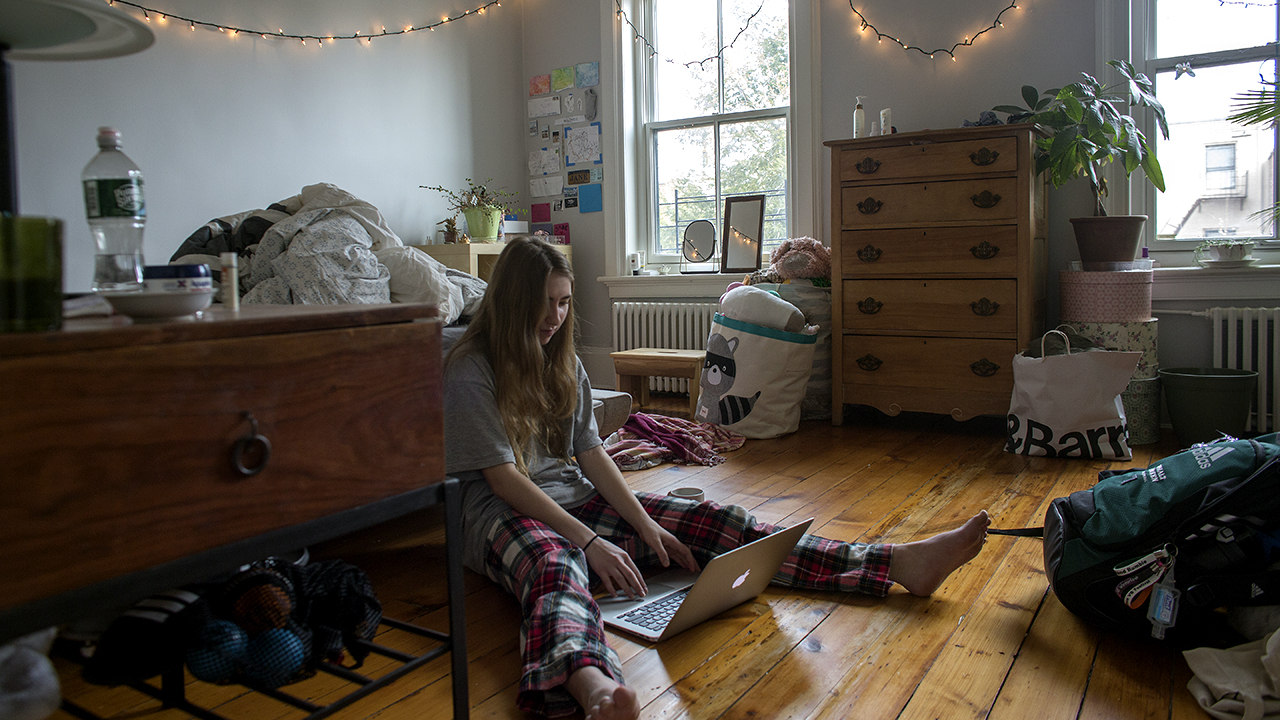
As K-12 officials in many states close schools and shift classes and assignments online due to the spread of the new coronavirus , they confront the reality that some students do not have reliable access to the internet at home – particularly those who are from lower-income households.
Here are key findings about the internet, homework and how the digital divide impacts American youth.
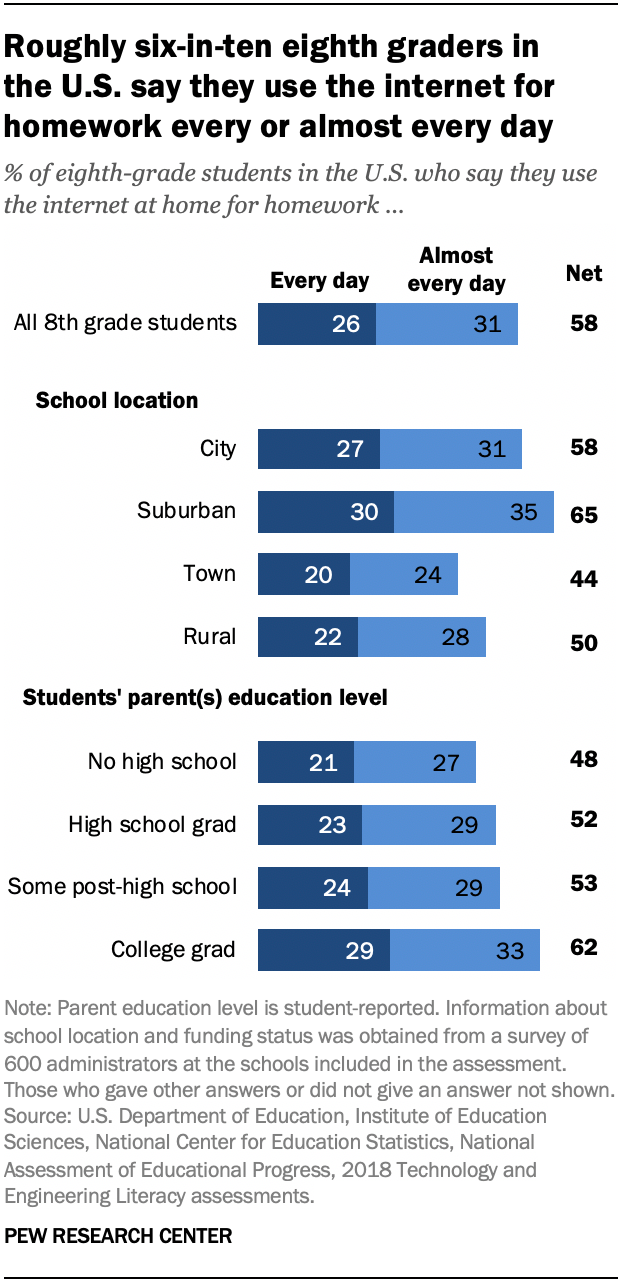
[bignumber]The majority of eighth-grade students in the United States rely on the internet at home to get their homework done. Roughly six-in-ten students (58%) say they use the internet at their home to do homework every day or almost every day, according to a new Pew Research Center analysis of data from the 2018 National Assessment of Educational Progress (NAEP). Just 6% of students say they never use the internet at home for this purpose.
There are differences in these patterns by community type and parents’ education level. Roughly two-thirds of students attending suburban schools (65%) say they use the internet for homework every day or almost every day, compared with 58% who attend schools in cities, 50% of those who attend in rural areas and 44% of those attending schools in towns. Students whose parents graduated from college are more likely to use the internet for homework at home. Some 62% of these students use the internet at home for homework, compared with smaller shares of students whose parents have some post-high school education (53%), have only a high school education (52%) or have no high school education (48%).
This analysis examines the impact of the internet and the digital divide on youth in the United States. The survey data cited here comes from a Pew Research Center poll of 743 U.S. teens conducted March 7 to April 10, 2018, using the NORC AmeriSpeak panel. AmeriSpeak is a nationally representative, probability-based panel of the U.S. household population. Randomly selected U.S. households are sampled with a known probability of selection from the NORC National Frame, and then contacted by U.S. mail, telephone or face-to-face interviewers. More details about the NORC AmeriSpeak panel methodology are available here .
Part of this analysis also relies on data from the 2018 National Assessment of Educational Progress (NAEP). The NAEP administers the digitally based Technology and Engineering Literacy assessment to better understand what students in the U.S. know and can do in the areas of technology and engineering. For more, see the assessment methodology .
Another part of this analysis uses the 2015 American Community Survey (ACS) data from the U.S. Census Bureau. The ACS is a national survey using continuous measurement methods. In the survey, a series of monthly samples produce annual estimates for the same small areas (census tracts and block groups) formerly surveyed via the decennial census long-form sample. For more, see the ACS methodology .
[bignumber]The “homework gap” – which refers to school-age children lacking the connectivity they need to complete schoolwork at home – is more pronounced for black, Hispanic and lower-income households. Some 15% of U.S. households with school-age children do not have a high-speed internet connection at home, according to a previously published Pew Research Center analysis of 2015 U.S. Census Bureau data. School-age children in lower-income households are especially likely to lack broadband access. Roughly one-third (35%) of households with children ages 6 to 17 and an annual income below $30,000 a year do not have a high-speed internet connection at home, compared with just 6% of such households earning $75,000 or more a year. These broadband gaps are particularly pronounced in black and Hispanic households with school-age children – especially those with low incomes.
[bignumber]Some lower-income teens say they lack resources to complete schoolwork at home. In a 2018 Center survey , about one-in-five teens ages 13 to 17 (17%) said they are often or sometimes unable to complete homework assignments because they do not have reliable access to a computer or internet connection. Black teens and those living in lower-income households were more likely to say they cannot complete homework assignments for this reason.
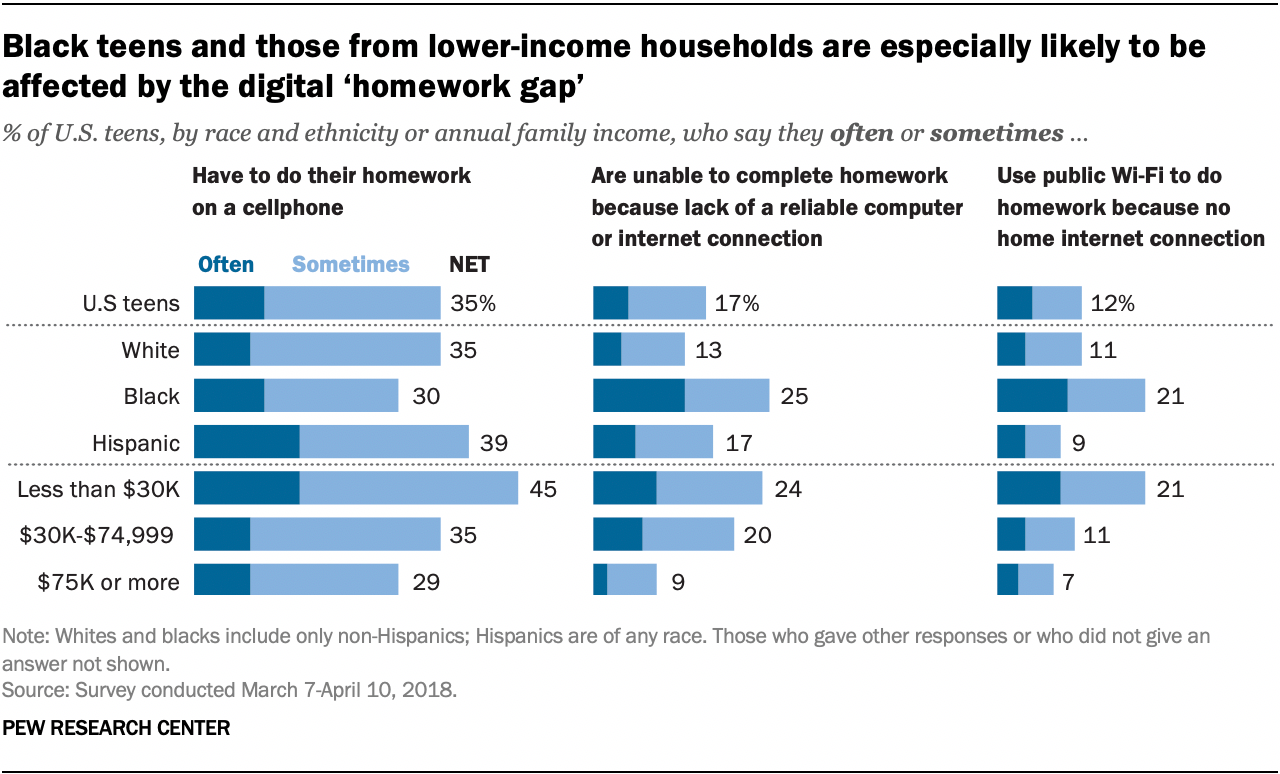
For example, one-quarter of black teens said they often or sometimes cannot do homework assignments due to lack of reliable access to a computer or internet connectivity, compared with 13% of white teens and 17% of Hispanic teens. Teens with an annual family income below $30,000 were also more likely to say this than teens with a family income of at least $75,000 a year (24% vs. 9%).
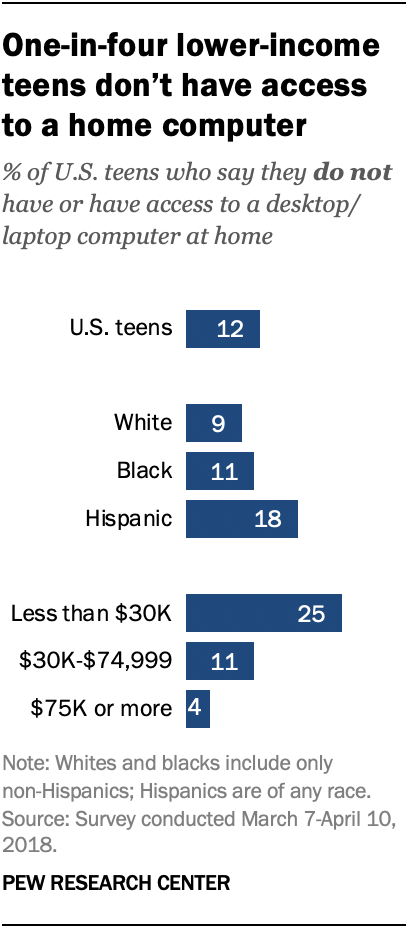
In the same survey, around one-in-ten teens (12%) said they often or sometimes use public Wi-Fi to do schoolwork because they lack a home internet connection. Again, black and lower-income teens were more likely to do this. Roughly one-in-five black teens (21%) said they use public Wi-Fi to do schoolwork due to a lack of home internet connection, compared with 11% of white teens and 9% of Hispanic teens. And around a fifth (21%) of teens with an annual family income under $30,000 reported having to use public Wi-Fi to do homework, compared with 11% of teens in families with a household income of $30,000-$74,999 and just 7% of those living in households earning at least $75,000.
[bignumber]A quarter of lower-income teens do not have access to a home computer. One-in-four teens in households with an annual income under $30,000 lack access to a computer at home, compared with just 4% of those in households earning over $75,000, according to the 2018 survey. There are also differences by race and ethnicity. Hispanic teens were especially likely to say they do not have access to a home computer: 18% said this, compared with 9% of white teens and 11% of black teens.
- Age & Generations
- COVID-19 & Politics
- COVID-19 & Technology
- Digital Divide
- Education & Learning Online
- Teens & Tech
- Teens & Youth
Brooke Auxier is a former research associate focusing on internet and technology at Pew Research Center .

Monica Anderson is a director of research at Pew Research Center .
Teens and Video Games Today
As biden and trump seek reelection, who are the oldest – and youngest – current world leaders, how teens and parents approach screen time, who are you the art and science of measuring identity, u.s. centenarian population is projected to quadruple over the next 30 years, most popular.
1615 L St. NW, Suite 800 Washington, DC 20036 USA (+1) 202-419-4300 | Main (+1) 202-857-8562 | Fax (+1) 202-419-4372 | Media Inquiries
Research Topics
- Email Newsletters
ABOUT PEW RESEARCH CENTER Pew Research Center is a nonpartisan fact tank that informs the public about the issues, attitudes and trends shaping the world. It conducts public opinion polling, demographic research, media content analysis and other empirical social science research. Pew Research Center does not take policy positions. It is a subsidiary of The Pew Charitable Trusts .
© 2024 Pew Research Center
Search form
National survey: students’ feelings about high school are mostly negative.

(© stock.adobe.com)
Ask a high school student how he or she typically feels at school, and the answer you’ll likely hear is “tired,” closely followed by “stressed” and “bored.”
In a nationwide survey of 21,678 U.S. high school students, researchers from the Yale Center for Emotional Intelligence and the Yale Child Study Center found that nearly 75% of the students’ self-reported feelings related to school were negative.
The study, which appeared in the January edition of the Journal of Learning and Instruction , also involved a second, “experience sampling” study in which 472 high school students in Connecticut reported their feelings at distinct moments throughout the school day. These momentary assessments told the same story: High school students reported negative feelings 60% of the time.
“ It was higher than we expected,” said co-author and research scientist Zorana Ivcevic . “We know from talking to students that they are feeling tired, stressed, and bored, but were surprised by how overwhelming it was.”
Students were recruited for the survey through email lists of partner schools and through social media channels from nonprofits like the Greater Good Science Center and Born this Way Foundation. The students represent urban, suburban, and rural school districts across all 50 states and both public and private schools. The researchers found that all demographic groups reported mostly negative feelings about school, but girls were slightly more negative than boys.
“ Overall,” said co-author Marc Brackett , “students see school as a place where they experience negative emotions.”
In the first online survey, students were asked to “think about the range of positive and negative feelings you have in school” and provide answers in three open text boxes. They were also asked to rate on a scale of 0 (never) to 100 (always) how often they felt 10 emotions: happy, proud, cheerful, joyful, lively, sad, mad, miserable, afraid, scared, stressed and bored.
In the open-ended responses, the most common emotion students reported was tired (58%). The next most-reported emotions — all just under 50% — were stressed, bored, calm, and happy. The ratings scale supported the findings, with students reporting feeling stressed (79.83%) and bored (69.51%) the most.
When those feelings are examined with more granularity, said Ivcevic, they reveal something interesting. The most-cited positive descriptions — calm and happy — are vague.
“ They are on the positive side of zero,” Ivcevic said, “but they are not energized or enthusiastic.” Feeling “interested” or “curious,” she noted, would reveal a high level of engagement that is predictive of deeper and more enduring learning.
She added that many of the negative feelings may be interrelated, with tiredness, for example, contributing to boredom or stress. “Boredom is in many ways similar to being tired,” she said. “It’s a feeling of being drained, low-energy. Physical states, such as being tired, can be at times misattributed as emotional states, such as boredom.”
The researchers noted that the way students feel at school has important implications in their performance and their overall health and well-being. “Students spend a lot of their waking time at school,” Ivcevic said. “Kids are at school to learn, and emotions have a substantial impact on their attention. If you’re bored, do you hear what’s being said around you?”
Public attention has turned recently to early start times for high schools in the U.S. and how that contributes to sleep deprivation among students, which is associated with a number of other health risks — including weight gain, depression, and drug use — and poor academic performance. The American Academy of Pediatrics has recommended that high schools start at 8:30 a.m. or later, but the vast majority start earlier .
“ It is possible that being tired is making school more taxing,” Ivcevic said, “so that it is more difficult for students to show curiosity and interest. It is like having an extra weight to carry.”
Unfortunately, she added, decisions about school start times are often not made with students’ health and wellbeing in mind. “There has been a movement in recent years to move school start times later,” she said. “The reasons for not moving it have nothing to do with students’ wellbeing or their ability to learn.” Instead, these decisions are often driven by concerns about athletic programs, extracurricular activities, and transportation.
At the Yale Center for Emotional Intelligence, where Brackett is founding director and lead developer of RULER, an evidence-based approach to social and emotional learning, the goal is to give students and staff the tools to use their emotions wisely. RULER doesn’t claim to prevent tiredness and boredom, but it is designed to help students to find an outlet for their feelings and to support teachers and students in developing emotion skills to promote greater engagement and enhance academic performance.
- Yale’s RULER program for EQ implemented at 37 PrepaTec schools in Mexico
Health & Medicine
Social Sciences
Media Contact
Fred Mamoun: [email protected] , 203-436-2643
This well-timed ‘chameleon’ sneaks up on drug-resistant brain cancers
Yale scientists say KL-50, their lead “chameleon” compound, effectively targets tumors without harming healthy surrounding tissue.

More than meets the eye: Understanding how the brain controls social gaze

Improving quality of care for older adults

Yale program hosts visiting economists from around the world
- Show More Articles
- May 28 Engi-near the finish line
- May 17 Love is in the air
- May 11 Art Car Club showcases its rolling artwork on wheels at the Orange Show parade
- May 3 Cultures collide at the Bellaire International Student Association Fest
- May 2 Uncalculated uncertainties

Three Penny Press

Students spend three times longer on homework than average, survey reveals
Sonya Kulkarni and Pallavi Gorantla | Jan 9, 2022

Graphic by Sonya Kulkarni
The National Education Association and the National Parent Teacher Association have suggested that a healthy number of hours that students should be spending can be determined by the “10-minute rule.” This means that each grade level should have a maximum homework time incrementing by 10 minutes depending on their grade level (for instance, ninth-graders would have 90 minutes of homework, 10th-graders should have 100 minutes, and so on).
As ‘finals week’ rapidly approaches, students not only devote effort to attaining their desired exam scores but make a last attempt to keep or change the grade they have for semester one by making up homework assignments.
High schoolers reported doing an average of 2.7 hours of homework per weeknight, according to a study by the Washington Post from 2018 to 2020 of over 50,000 individuals. A survey of approximately 200 Bellaire High School students revealed that some students spend over three times this number.
The demographics of this survey included 34 freshmen, 43 sophomores, 54 juniors and 54 seniors on average.
When asked how many hours students spent on homework in a day on average, answers ranged from zero to more than nine with an average of about four hours. In contrast, polled students said that about one hour of homework would constitute a healthy number of hours.
Junior Claire Zhang said she feels academically pressured in her AP schedule, but not necessarily by the classes.
“The class environment in AP classes can feel pressuring because everyone is always working hard and it makes it difficult to keep up sometimes.” Zhang said.
A total of 93 students reported that the minimum grade they would be satisfied with receiving in a class would be an A. This was followed by 81 students, who responded that a B would be the minimum acceptable grade. 19 students responded with a C and four responded with a D.
“I am happy with the classes I take, but sometimes it can be very stressful to try to keep up,” freshman Allyson Nguyen said. “I feel academically pressured to keep an A in my classes.”
Up to 152 students said that grades are extremely important to them, while 32 said they generally are more apathetic about their academic performance.
Last year, nine valedictorians graduated from Bellaire. They each achieved a grade point average of 5.0. HISD has never seen this amount of valedictorians in one school, and as of now there are 14 valedictorians.
“I feel that it does degrade the title of valedictorian because as long as a student knows how to plan their schedule accordingly and make good grades in the classes, then anyone can be valedictorian,” Zhang said.
Bellaire offers classes like physical education and health in the summer. These summer classes allow students to skip the 4.0 class and not put it on their transcript. Some electives also have a 5.0 grade point average like debate.
Close to 200 students were polled about Bellaire having multiple valedictorians. They primarily answered that they were in favor of Bellaire having multiple valedictorians, which has recently attracted significant acclaim .
Senior Katherine Chen is one of the 14 valedictorians graduating this year and said that she views the class of 2022 as having an extraordinary amount of extremely hardworking individuals.
“I think it was expected since freshman year since most of us knew about the others and were just focused on doing our personal best,” Chen said.
Chen said that each valedictorian achieved the honor on their own and deserves it.
“I’m honestly very happy for the other valedictorians and happy that Bellaire is such a good school,” Chen said. “I don’t feel any less special with 13 other valedictorians.”
Nguyen said that having multiple valedictorians shows just how competitive the school is.
“It’s impressive, yet scary to think about competing against my classmates,” Nguyen said.
Offering 30 AP classes and boasting a significant number of merit-based scholars Bellaire can be considered a competitive school.
“I feel academically challenged but not pressured,” Chen said. “Every class I take helps push me beyond my comfort zone but is not too much to handle.”
Students have the opportunity to have off-periods if they’ve met all their credits and are able to maintain a high level of academic performance. But for freshmen like Nguyen, off periods are considered a privilege. Nguyen said she usually has an hour to five hours worth of work everyday.
“Depending on the day, there can be a lot of work, especially with extra curriculars,” Nguyen said. “Although, I am a freshman, so I feel like it’s not as bad in comparison to higher grades.”
According to the survey of Bellaire students, when asked to evaluate their agreement with the statement “students who get better grades tend to be smarter overall than students who get worse grades,” responders largely disagreed.
Zhang said that for students on the cusp of applying to college, it can sometimes be hard to ignore the mental pressure to attain good grades.
“As a junior, it’s really easy to get extremely anxious about your GPA,” Zhang said. “It’s also a very common but toxic practice to determine your self-worth through your grades but I think that we just need to remember that our mental health should also come first. Sometimes, it’s just not the right day for everyone and one test doesn’t determine our smartness.”

HUMANS OF BELLAIRE – Austin Schmidt

HUMANS OF BELLAIRE – Michael Sheth

Q&A with presidential debate national qualifier

HUMANS OF BELLAIRE – Alberto Bernardoni

Engi-near the finish line

Love is in the air

Art Car Club showcases its rolling artwork on wheels at the Orange Show parade

Cultures collide at the Bellaire International Student Association Fest
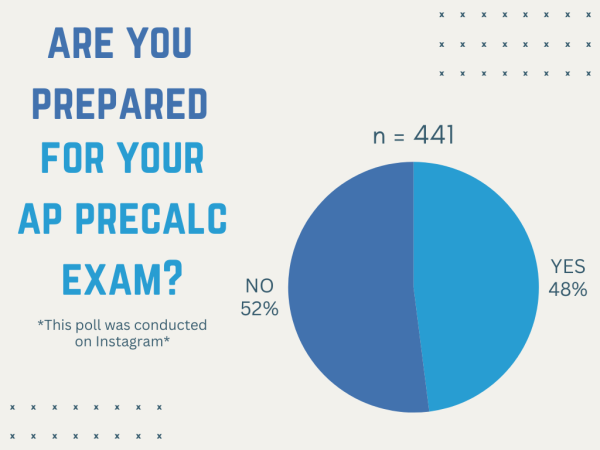
Uncalculated uncertainties
Humans of Bellaire

HUMANS OF BELLAIRE – Elisa Adams

HUMANS OF BELLAIRE – Achilles Glenn

HUMANS OF BELLAIRE – Maurya Manjunath

Gather around the campfire

HUMANS OF BELLAIRE – Alara Bozkurt
The student news site of Bellaire High School
- Letter to the Editor
- Submit a Story Idea
- Advertising/Sponsorships
Comments (7)
Cancel reply
Your email address will not be published. Required fields are marked *
Anonymous • Nov 21, 2023 at 10:32 am
It’s not really helping me understand how much.
josh • May 9, 2023 at 9:58 am
Kassie • May 6, 2022 at 12:29 pm
Im using this for an English report. This is great because on of my sources needed to be from another student. Homework drives me insane. Im glad this is very updated too!!
Kaylee Swaim • Jan 25, 2023 at 9:21 pm
I am also using this for an English report. I have to do an argumentative essay about banning homework in schools and this helps sooo much!
Izzy McAvaney • Mar 15, 2023 at 6:43 pm
I am ALSO using this for an English report on cutting down school days, homework drives me insane!!
E. Elliott • Apr 25, 2022 at 6:42 pm
I’m from Louisiana and am actually using this for an English Essay thanks for the information it was very informative.
Nabila Wilson • Jan 10, 2022 at 6:56 pm
Interesting with the polls! I didn’t realize about 14 valedictorians, that’s crazy.
- Share full article
Advertisement
Supported by
The Algebra Problem: How Middle School Math Became a National Flashpoint
Top students can benefit greatly by being offered the subject early. But many districts offer few Black and Latino eighth graders a chance to study it.

By Troy Closson
From suburbs in the Northeast to major cities on the West Coast, a surprising subject is prompting ballot measures, lawsuits and bitter fights among parents: algebra.
Students have been required for decades to learn to solve for the variable x, and to find the slope of a line. Most complete the course in their first year of high school. But top-achievers are sometimes allowed to enroll earlier, typically in eighth grade.
The dual pathways inspire some of the most fiery debates over equity and academic opportunity in American education.
Do bias and inequality keep Black and Latino children off the fast track? Should middle schools eliminate algebra to level the playing field? What if standout pupils lose the chance to challenge themselves?
The questions are so fraught because algebra functions as a crucial crossroads in the education system. Students who fail it are far less likely to graduate. Those who take it early can take calculus by 12th grade, giving them a potential edge when applying to elite universities and lifting them toward society’s most high-status and lucrative professions.
But racial and economic gaps in math achievement are wide in the United States, and grew wider during the pandemic. In some states, nearly four in five poor children do not meet math standards.
To close those gaps, New York City’s previous mayor, Bill de Blasio, adopted a goal embraced by many districts elsewhere. Every middle school would offer algebra, and principals could opt to enroll all of their eighth graders in the class. San Francisco took an opposite approach: If some children could not reach algebra by middle school, no one would be allowed to take it.
The central mission in both cities was to help disadvantaged students. But solving the algebra dilemma can be more complex than solving the quadratic formula.
New York’s dream of “algebra for all” was never fully realized, and Mayor Eric Adams’s administration changed the goal to improving outcomes for ninth graders taking algebra. In San Francisco, dismantling middle-school algebra did little to end racial inequities among students in advanced math classes. After a huge public outcry, the district decided to reverse course.
“You wouldn’t think that there could be a more boring topic in the world,” said Thurston Domina, a professor at the University of North Carolina. “And yet, it’s this place of incredibly high passions.”
“Things run hot,” he said.
In some cities, disputes over algebra have been so intense that parents have sued school districts, protested outside mayors’ offices and campaigned for the ouster of school board members.
Teaching math in middle school is a challenge for educators in part because that is when the material becomes more complex, with students moving from multiplication tables to equations and abstract concepts. Students who have not mastered the basic skills can quickly become lost, and it can be difficult for them to catch up.
Many school districts have traditionally responded to divergent achievement levels by simply separating children into distinct pathways, placing some in general math classes while offering others algebra as an accelerated option. Such sorting, known as tracking, appeals to parents who want their children to reach advanced math as quickly as possible.
But tracking has cast an uncomfortable spotlight on inequality. Around a quarter of all students in the United States take algebra in middle school. But only about 12 percent of Black and Latino eighth graders do, compared with roughly 24 percent of white pupils, a federal report found .
“That’s why middle school math is this flashpoint,” said Joshua Goodman, an associate professor of education and economics at Boston University. “It’s the first moment where you potentially make it very obvious and explicit that there are knowledge gaps opening up.”
In the decades-long war over math, San Francisco has emerged as a prominent battleground.
California once required that all eighth graders take algebra. But lower-performing middle school students often struggle when forced to enroll in the class, research shows. San Francisco later stopped offering the class in eighth grade. But the ban did little to close achievement gaps in more advanced math classes, recent research has found.
As the pendulum swung, the only constant was anger. Leading Bay Area academics disparaged one another’s research . A group of parents even sued the district last spring. “Denying students the opportunity to skip ahead in math when their intellectual ability clearly allows for it greatly harms their potential for future achievement,” their lawsuit said.
The city is now back to where it began: Middle school algebra — for some, not necessarily for all — will return in August. The experience underscored how every approach carries risks.
“Schools really don’t know what to do,” said Jon R. Star, an educational psychologist at Harvard who has studied algebra education. “And it’s just leading to a lot of tension.”
In Cambridge, Mass., the school district phased out middle school algebra before the pandemic. But some argued that the move had backfired: Families who could afford to simply paid for their children to take accelerated math outside of school.
“It’s the worst of all possible worlds for equity,” Jacob Barandes, a Cambridge parent, said at a school board meeting.
Elsewhere, many students lack options to take the class early: One of Philadelphia’s most prestigious high schools requires students to pass algebra before enrolling, preventing many low-income children from applying because they attend middle schools that do not offer the class.
In New York, Mr. de Blasio sought to tackle the disparities when he announced a plan in 2015 to offer algebra — but not require it — in all of the city’s middle schools. More than 15,000 eighth graders did not have the class at their schools at the time.
Since then, the number of middle schools that offer algebra has risen to about 80 percent from 60 percent. But white and Asian American students still pass state algebra tests at higher rates than their peers.
The city’s current schools chancellor, David Banks, also shifted the system’s algebra focus to high schools, requiring the same ninth-grade curriculum at many schools in a move that has won both support and backlash from educators.
And some New York City families are still worried about middle school. A group of parent leaders in Manhattan recently asked the district to create more accelerated math options before high school, saying that many young students must seek out higher-level instruction outside the public school system.
In a vast district like New York — where some schools are filled with children from well-off families and others mainly educate homeless children — the challenge in math education can be that “incredible diversity,” said Pedro A. Noguera, the dean of the University of Southern California’s Rossier School of Education.
“You have some kids who are ready for algebra in fourth grade, and they should not be denied it,” Mr. Noguera said. “Others are still struggling with arithmetic in high school, and they need support.”
Many schools are unequipped to teach children with disparate math skills in a single classroom. Some educators lack the training they need to help students who have fallen behind, while also challenging those working at grade level or beyond.
Some schools have tried to find ways to tackle the issue on their own. KIPP charter schools in New York have added an additional half-hour of math time to many students’ schedules, to give children more time for practice and support so they can be ready for algebra by eighth grade.
At Middle School 50 in Brooklyn, where all eighth graders take algebra, teachers rewrote lesson plans for sixth- and seventh-grade students to lay the groundwork for the class.
The school’s principal, Ben Honoroff, said he expected that some students would have to retake the class in high school. But after starting a small algebra pilot program a few years ago, he came to believe that exposing children early could benefit everyone — as long as students came into it well prepared.
Looking around at the students who were not enrolling in the class, Mr. Honoroff said, “we asked, ‘Are there other kids that would excel in this?’”
“The answer was 100 percent, yes,” he added. “That was not something that I could live with.”
Troy Closson reports on K-12 schools in New York City for The Times. More about Troy Closson

IMAGES
VIDEO
COMMENTS
A 2018 Pew Research poll of 743 US teens found that 17%, or almost 2 in every 5 students, regularly struggled to complete homework because they didn't have reliable access to the internet. This figure rose to 25% of Black American teens and 24% of teens whose families have an income of less than $30,000 per year. 4.
Overall, 17% of teens say they are often or sometimes unable to complete homework assignments because they do not have reliable access to a computer or internet connection. This is even more common among black teens. One-quarter of black teens say they are at least sometimes unable to complete their homework due to a lack of digital access ...
Forty-three percent viewed tests as a primary stressor, while 33 percent put the pressure to get good grades in that category. Less than 1 percent of the students said homework was not a stressor. • Reductions in health: In their open-ended answers, many students said their homework load led to sleep deprivation and other health problems. The ...
The answer may not be to eliminate homework completely but to be more mindful of the type of work students take home, suggests Kang, who was a high school teacher for 10 years.
Why do students need more interactive homework? ... This, of course is true, but many kindergarten kids are excited to have homework like their older siblings. If they give homework, most teachers of young children make assignments very short—often following an informal rule of 10 minutes per grade level. "No homework" does not guarantee that ...
Want more writing prompts? You can find all of our questions in our Student Opinion column.Teachers, check out this guide to learn how you can incorporate them into your classroom. Students 13 and ...
For high schoolers, Cooper's research suggests that two hours per night is optimal. If teens have more than two hours of homework a night, their academic success flatlines. But less is not better. The average high school student doing homework outperformed 69 percent of the students in a class with no homework.
A year into the outbreak, an increasing share of U.S. adults said that K-12 schools have a responsibility to provide all students with laptop or tablet computers in order to help them complete their schoolwork at home during the pandemic. About half of all adults (49%) said this in the spring 2021 survey, up 12 percentage points from a year ...
One federal survey found that 70 percent of American teachers assign homework that needs to be done online; 90 percent of high schoolers say they have to do internet-based homework at least a few ...
October 1, 2003. Two new reports debunk the notion that U.S. schoolchildren suffer from a growing homework load, with little time to play and just be kids. The great majority of students at all ...
It was 6% in 1984. The amount of homework for 13-year-olds appears to have lightened slightly. Students with one to two hours of homework declined from 29% to 23%. The next category down (in terms ...
In that poll teens reported spending, on average, more than three hours on homework each school night, with 11th graders spending more time on homework than any other grade level. By contrast ...
The National PTA and the National Education Association support the "10-minute homework guideline"—a nightly 10 minutes of homework per grade level. But many teachers and parents are quick to point out that what matters is the quality of the homework assigned and how well it meets students' needs, not the amount of time spent on it.
Among all high school students surveyed (those that reported completing their homework and those that did not), the time allocated to complete homework amounted to less than an hour per day ...
Today, homework often requires a computer and/or internet connection, which many students do not have access to outside of school. Sources: NEAToday.org, " The Homework Gap: The 'Cruelest Part of the Digital Divide' ," 2016; CNET.com, " The Digital Divide Has Left Millions of School Kids Behind ," 2021.
What is the "Right" Amount of Homework? Research suggests that homework should not exceed 1.5 to 2.5 hours per night for high school students and no more than 1 hour per night for middle ...
Writing the piece as a letter to his younger brother, he said: "In a 2020 Washington Post article, Denise Pope described what she learned from a survey of more than 50,000 high school students ...
Homework allows for more time to complete the learning process. School hours are not always enough time for students to really understand core concepts, and homework can counter the effects of time shortages, benefiting students in the long run, even if they can't see it in the moment. 6. Homework Reduces Screen Time.
Students whose parents graduated from college are more likely to use the internet for homework at home. Some 62% of these students use the internet at home for homework, compared with smaller shares of students whose parents have some post-high school education (53%), have only a high school education (52%) or have no high school education (48%).
It is quite a mixed picture. A big report for the Department for Education, published in 2014, concluded that students in Year 9 who spent between two and three hours on homework on an average ...
In a nationwide survey of 21,678 U.S. high school students, researchers from the Yale Center for Emotional Intelligence and the Yale Child Study Center found that nearly 75% of the students' self-reported feelings related to school were negative. The study, which appeared in the January edition of the Journal of Learning and Instruction, also ...
A survey of approximately 200 Bellaire High School students revealed that some students spend over three times this number. The demographics of this survey included 34 freshmen, 43 sophomores, 54 juniors and 54 seniors on average. When asked how many hours students spent on homework in a day on average, answers ranged from zero to more than ...
Looking around at the students who were not enrolling in the class, Mr. Honoroff said, "we asked, 'Are there other kids that would excel in this?'" "The answer was 100 percent, yes ...
School districts can apply on behalf of their students to participate. Project 10Million offers 100GBs/year of free data, free mobile hotspots and access to at-cost laptops and tablets, to students eligible for the National School Lunch Program (NSLP)—one per household.